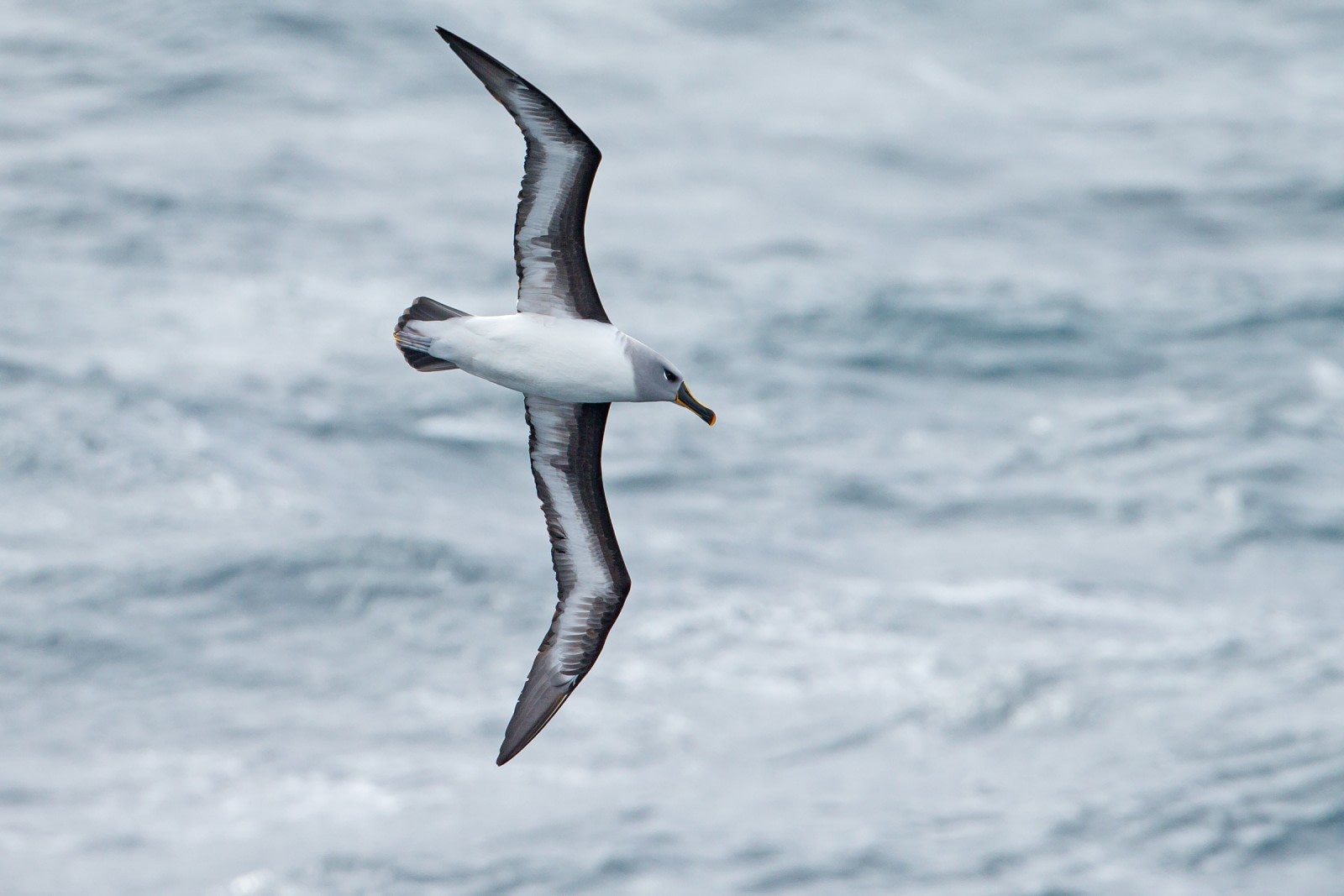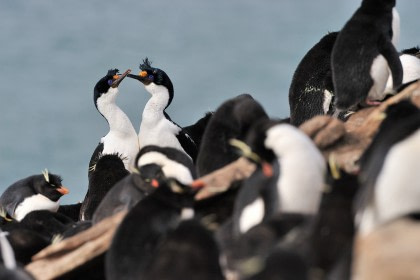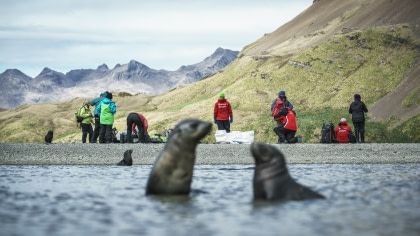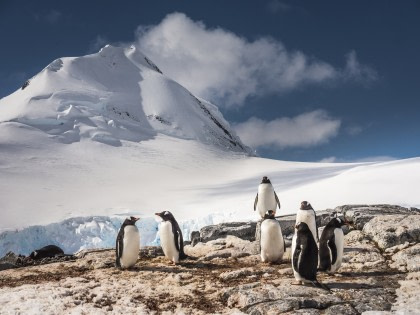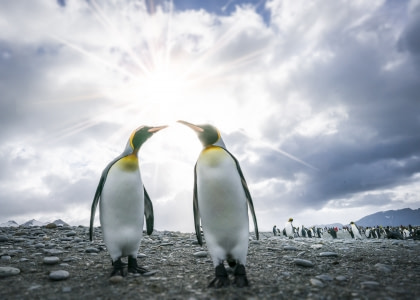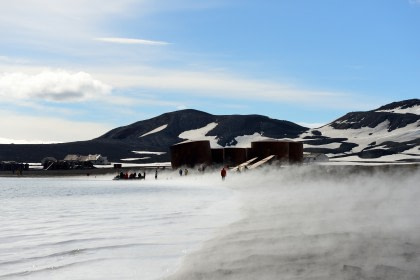Sailing from Puerto Madryn (3 November)
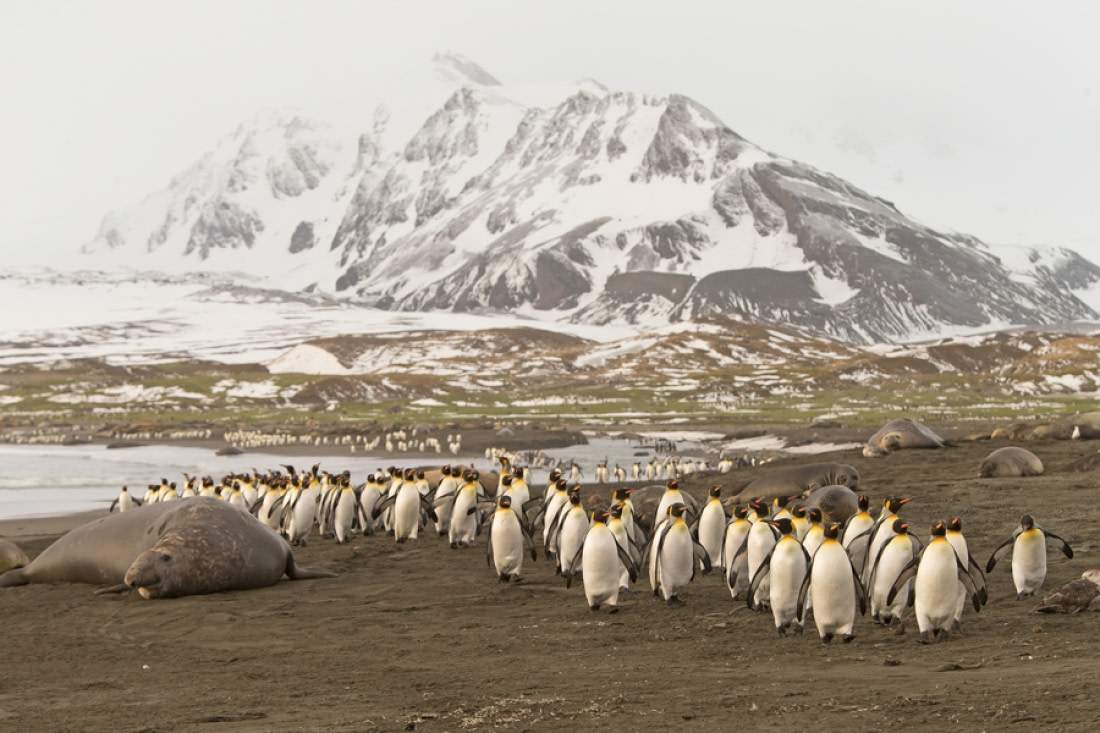
St Andrew’s Bay beach scene, South Georgia (Mike Watson)
Once we had boarded the lovely m/v Plancius, moored along the jetty at Puerto Madryn, and had completed the necessary embarkation formalities, there was a little time to watch for wildlife as we sailed away from Valdes Peninsula.
As we had sat in the bus waiting to take us to our ship, we had watched the distant southern right whales in the bay, so full of energy, with much breaching and fluke waving.
Southern giant petrels zoomed around, and there were some interesting birds in the bay itself, notably great grebes. Three South American sealions were slumbering on the pilings of the jetty behind our ship, but these soon departed when the time came to leave our moorings.
As the sun dipped on the western horizon, we were treated to a truly stunning sunset, with the sky over the Valdes Peninsula on fire and happily still some seabirds flying against it to satisfy the artists amongst us.
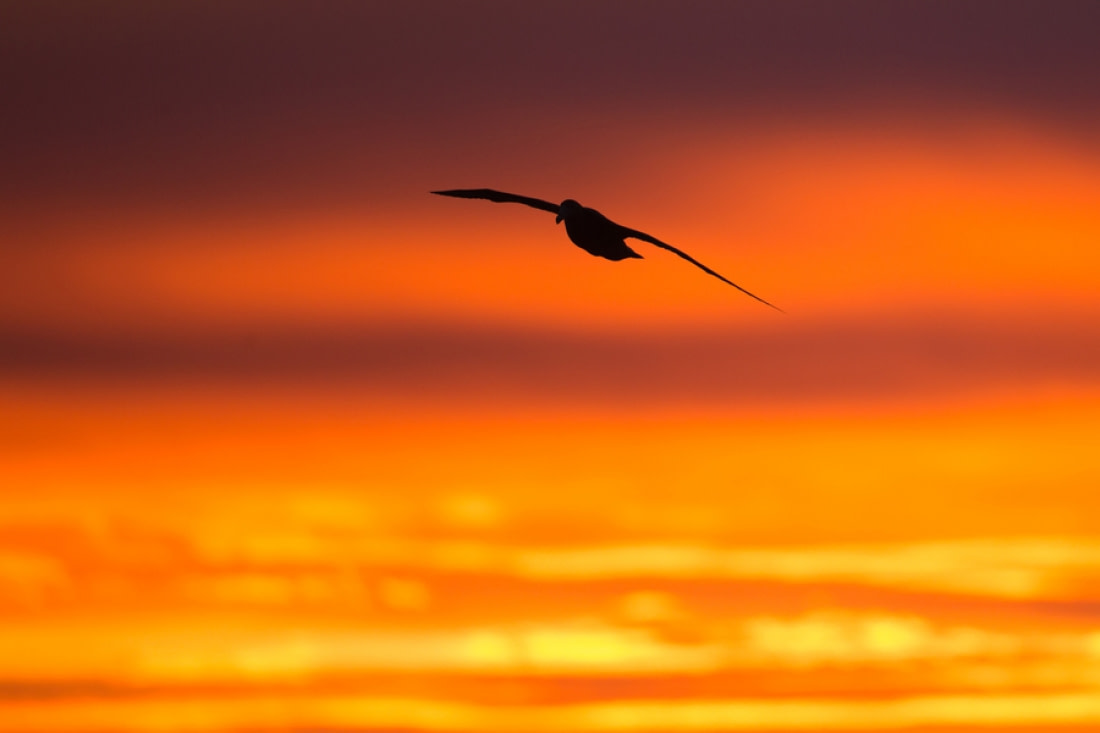
Valdes Peninsula sunset (Mike Watson)
Cruising towards the Falkland Islands (4 – 5 November)
After a very pleasant rolling night’s sleep, we awoke to a lovely sunny day at sea, with lots of seabirds around Plancius all day as we continued southeast towards the Falkland Islands, roughly following the South American continental shelf.
The moderate swell and following wind meant that the great albatrosses were on the wing and occasionally zooming in to check us out like light aircraft. They are always such a thrill, and we could identify wandering and both northern and southern royal albatrosses amongst hundreds of black-browed.
There were also hundreds of southern giant petrels and cape and white-chinned petrels. However, the commonest seabird today by far was slender-billed prion, which could be seen in several tight flocks, each containing a thousand or so birds.
Wilson’s storm petrels were another common sight today. Bird of the day today, however, was the great shearwater, with around 20 logged. This would be the only day we saw this smart shearwater, now back in its Austral summer latitudes.
A single manx shearwater and our first handful of sooty shearwaters were also seen. There was still a mob of kelp gulls following us today and a number of South American and Arctic terns was noted.
Two of three jaegers we saw could be identified as parasitic. Four Magellanic penguins were seen in the water as we cruised by, and several small groups of smart little peale’s dolphins rode the bow of Plancius throughout a brilliant day of seabirding.
We were even treated to a double green flash as the sun set over a bumpy sea, our own movement creating this effect.
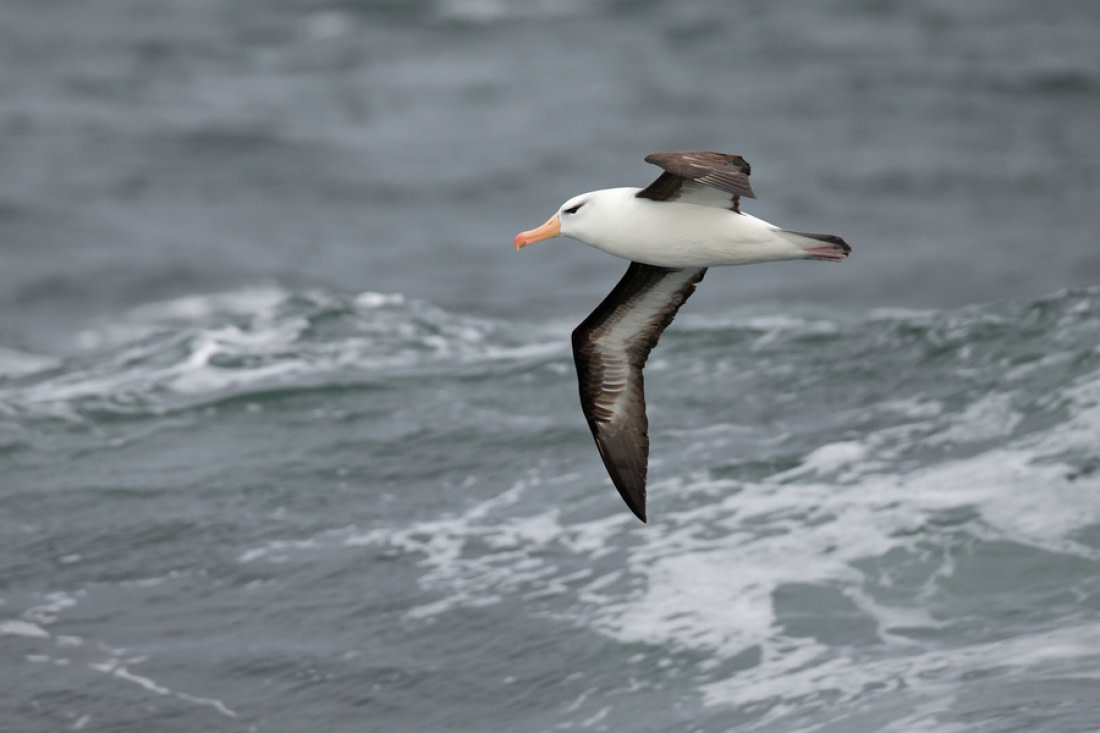
Black-browed Albatross at sea west of the Falklands (Mike Watson)
Another day cruising steadily towards the Falkland Islands saw a bigger swell, but with the wind behind us, Plancius steered an easy rolling course through even the biggest waves.
Most of our little band of birders spent the day on deck seabirding or sleeping as we came to enjoy the rolling life on the ocean wave. The composition of the birds around us changed today, with noticeably fewer of most things, except southern and north royal albatrosses and Sooty Shearwaters.
Northern giant petrel, grey-backed storm petrel, and brown skua put in their first appearances today as the bow deck was closed. Most seabirding took place from the bridge wings, where there is much more movement but at least shelter from the spray.
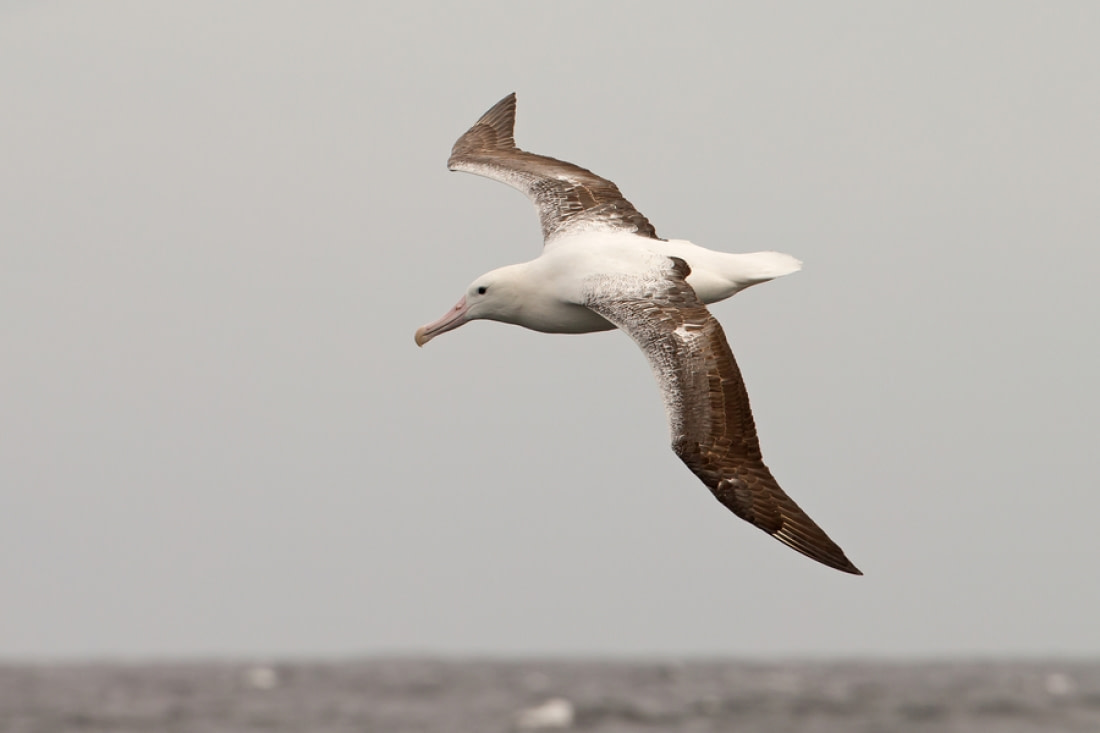
Southern Royal Albatross at sea west of the Falklands (Mike Watson)
The Falkland Islands, Westpoint Island, and Grave Cove (6 November)
The Falkland Islands are situated almost 500 km (310 miles) to the east of Patagonia, at around 52 degrees.
As we awoke we were passing the world’s largest black-browed albatross colony on Steeple Jason, one of the most northwesterly of the Falkland Islands. The albatrosses filled the sky above the western tip of the island like insects.
Our original plan was to land on Steeple Jason (where there are cobb’s wrens) and Saunders Island, but unfortunately the landing sites were now exposed to a big southwesterly swell.
Carcass Island, a fallback location for cobb’s wrens, was also out of bounds today in the exceptionally windy weather from the southwest, and we cruised onwards towards plan B.
Waiting to board the Zodiacs for the first time, we could already see birds along the kelp-covered shoreline: upland and kelp geese as well as a few Falkland Islands steamer ducks.
Westpoint is a very pretty location indeed. Once on shore we quickly added the even prettier ruddy-headed goose, austral thrush, long-tailed meadowlark, and dark-faced ground tyrant, and there was a skulking grass wren, in a stream gully by the shore.
A steamer duck was watched close to the landing jetty, a big ungainly duck diving frequently. We then hiked into a headwind across the island to the simply awesome Devil’s Nose albatross and penguin colony.
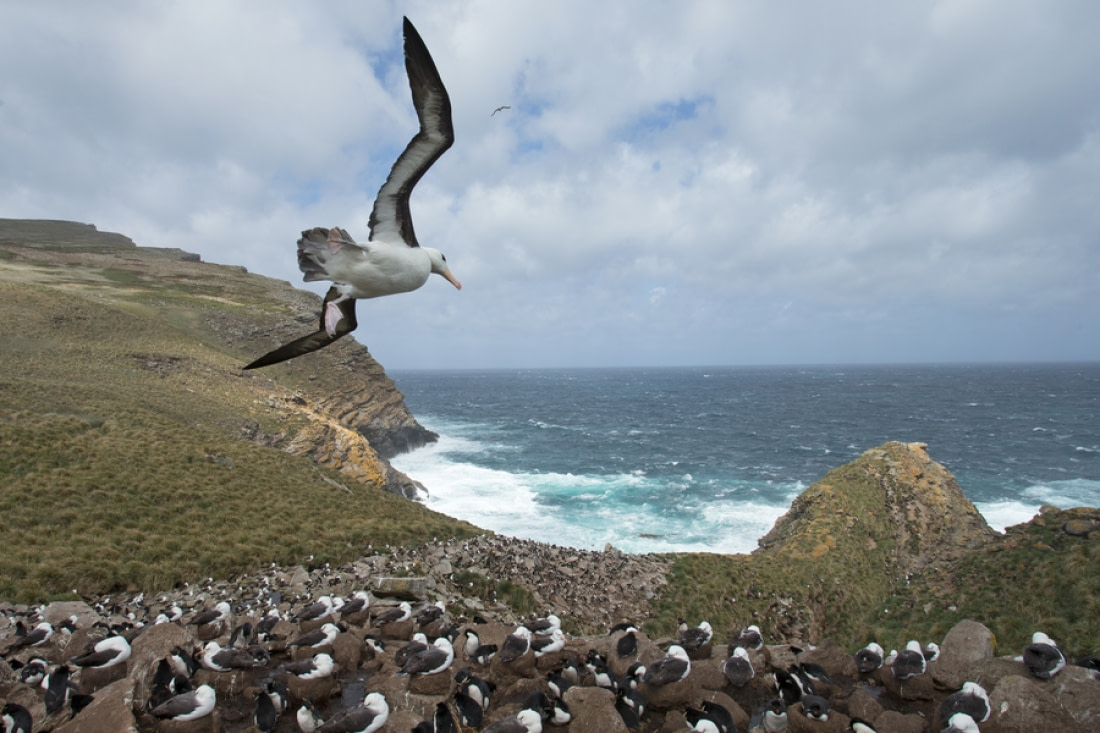
Black-browed Albatross colony at the Devil's Nose, Westpoint (Mike Watson)
Perched at the head of a geo overlooking surf crashing on the rocky shore far below, a throng of black-browed albatrosses and smart southern rockhopper penguins jostled for a limited number of mud stool nests.
We were able to watch them at very close range, with albatrosses hanging in the wind as they came in to land overhead. We could feel the rush of air of their two-metre wingspans. Fab-u-lous!
Against a lovely yellow backdrop of (the introduced) gorse bushes, we also saw some Falkland land birds in the form of striated caracara, correndera pipit, black-chinned siskin, and blackish cinclodes, which was singing and foraging among the seaweed covered rocks on the shore.
Some of us had a Chilean swallow here too, an uncommon Falkland Islands bird.
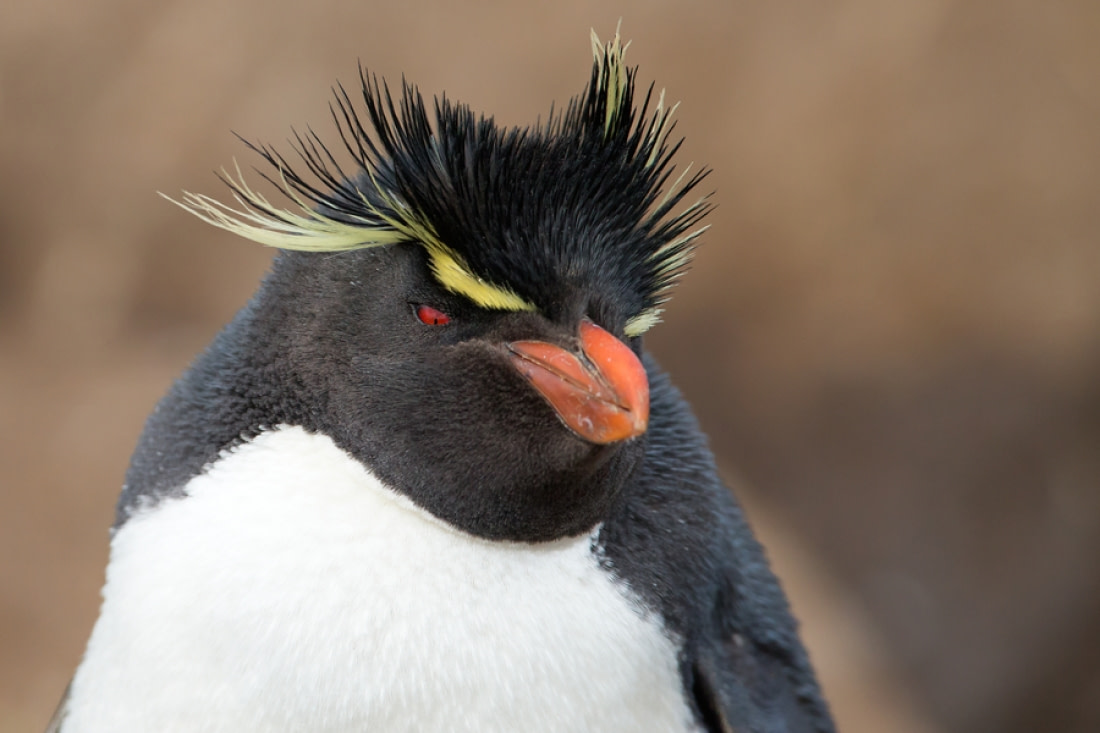
Southern Rockhopper Penguin (Mike Watson)
We relocated in the afternoon to Grave Cove on West Falkland, where Richard spotted a pod of the gorgeous black-and-white commerson’s dolphin from the dinner table!
We dashed out and watched them around Plancius. They hung around long enough to check out the Zodiac operation to the cove itself.
Once ashore, the very hospitable landowner, Marie Paule, met us and guided us towards the opposite side of the island, where a windswept beach was the perfect setting for some returning gentoo penguins of the more than 6,000-bird colony on the island.
To say it was windswept is putting it mildly: I have never been blown off my feet before, and I weigh only just short of 100 kg (220 pounds)!
The striated caracaras were particularly obliging here, allowing very close approach as they foraged nearby. In the evening we cruised north through the outer islands and then turned east along the north coastline, on our way to the capital Port Stanley, where we would go ashore the next day.
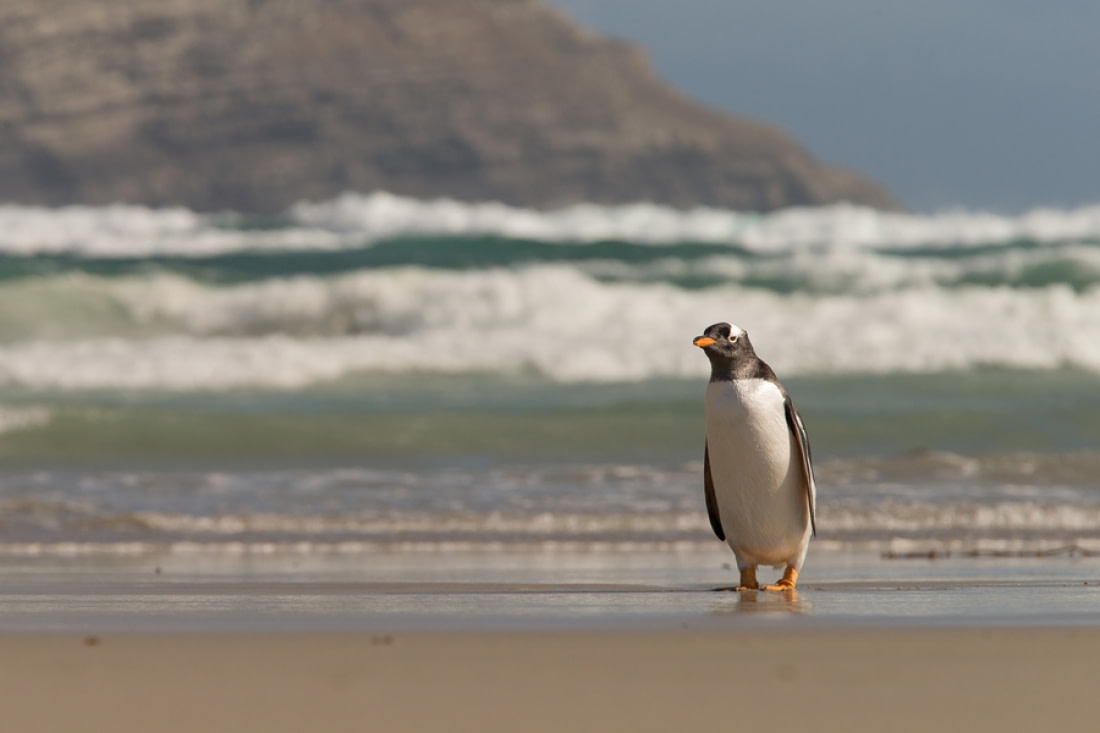
Gentoo Penguin (Mike Watson)
Stanley, Falkland Islands (7 November)
As we cruised down the northeast coast of East Falkland, we started to see lots of sooty shearwaters, our first significant numbers of this abundant southern ocean seabird. We also saw eight southern fulmars in this area, quite a good number for this latitude.
Turning back west into the narrows at the entrance to William Harbor, imperial shags were noted in higher numbers, and kelp gulls found us again.
Stanley and its surrounding area was a focal point of the 1982 Falklands conflict, and the names of the Royal Navy vessels assigned to protect the islands through the ages are commemorated on the shore opposite the city – Barracouta, Beagle, Protector, Endurance, Dumbarton Castle and Clyde.
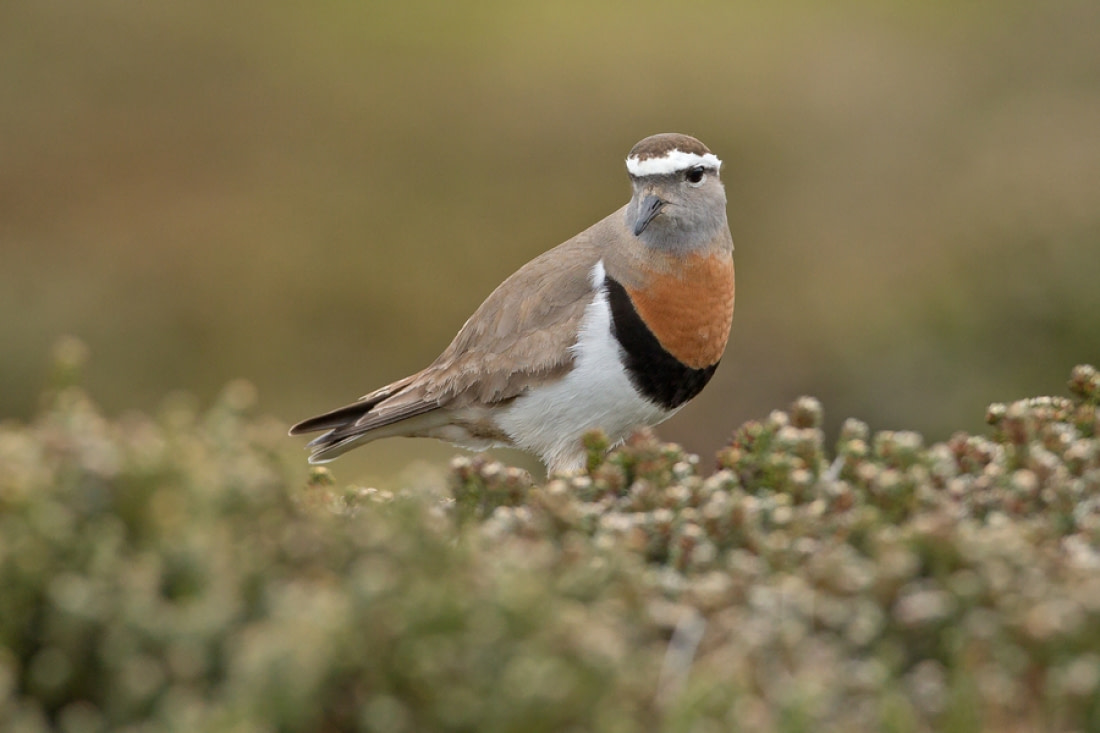
Rufous-chested Dotterel at Cape Pembroke, East Falkland (Mike Watson)
Once ashore, we met our local birding guide, Brian Sullivan, for a special excursion. We enjoyed a fantastic morning of birding to the east of the city, towards Cape Pembroke.
Starting at the aptly named windswept Surf Bay, we quickly spotted the hoped for two-banded plover, several of which were feeding in gnarled pieces of kelp above the high water mark. The lovely white sand beach also held a migrant white-rumped sandpiper, a very long distance Arctic-breeding migrant, newly returned to East Falkland for the winter.
After enjoying some fine close views of the very confident plovers, we continued inland from the beach, seeing another very confiding shorebird, South American (or Magellanic) snipe, which also allowed close approach.
It was not too long before we were looking at a third shorebird, a little further along the Cape Pembroke road, and best of all, the gorgeous rufous-chested dotterel. They were also approachable, and we later discovered they had small chicks nearby.
We saw three pairs in total, including one of them next to a water-filled crater made by one the RAF Vulcan’s 1000-pound bombs dropped during the war. Brian pointed out some smaller bomb craters from Hawker Harrier 500-pound bombs.
Also here were some very showy correndera pipits and on nearby pools, upland and ruddy-headed geese, crested duck, silver teal, chiloe wigeon, and yellow-billed pintail.
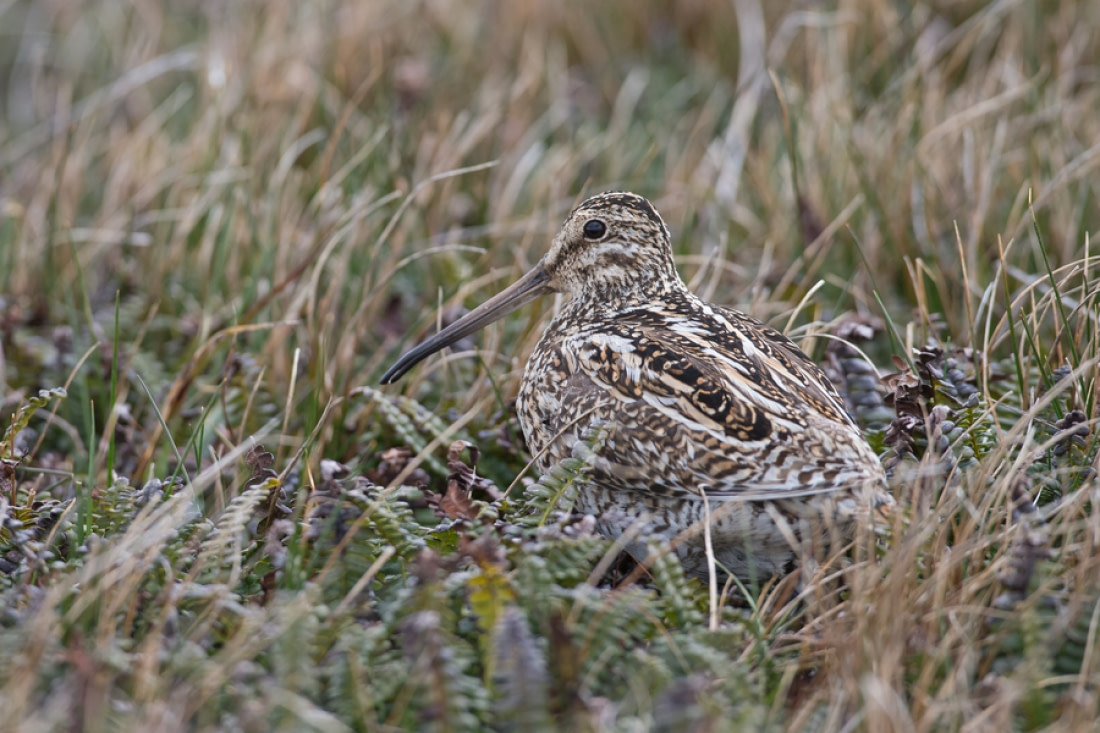
South American Snipe, Cape Pembroke (Mike Watson)
As Sergeant Major of the British Territorial Army regiment in Stanley at the time of the 1982 invasion, Brian was held as a prisoner of war under house arrest in West Falkland and so missed the arrival of the British forces.
He was able to point out numerous landmarks surrounding Stanley, which had featured in the war. Many of the pretty beaches of this part of East Falkland were mined by the Argentinians, who anticipated an attack from the east.
The British forces attacked from the west instead, having landed at San Carlos, some 56 miles to the west, and yomped over the peatlands to Stanley in three days, each man carrying a 36-kg (79 pounds) load.
Many minefields have now been cleared, often by Zimbabwean experts, but also by unfortunate sheep, and we can now visit some previously off limits sites.
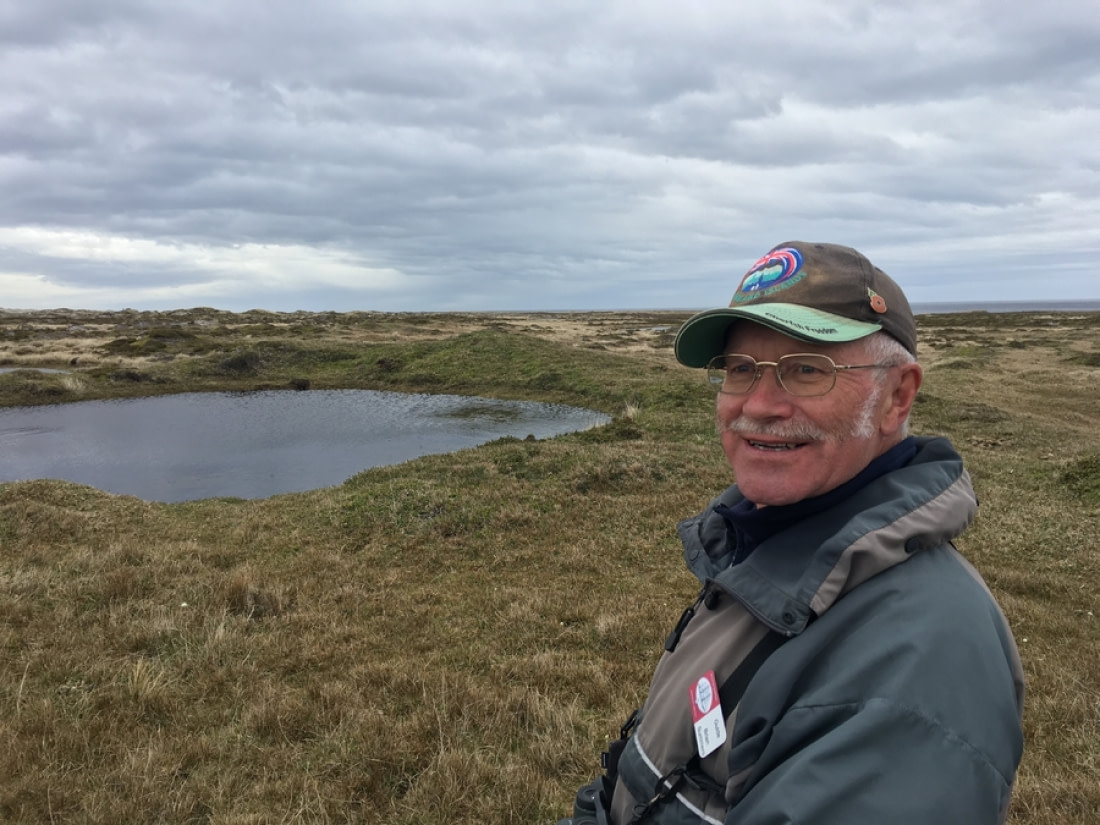
Sgt Major Brian Sullivan by one of the 1982 RAF Vulcan bomb craters (Mike Watson)
One such place is Gypsy Bay, where we were able to enjoy some point-blank views of Magellanic penguins in and next to their burrows. Magic!
Also here were grass wrens singing, black-chinned siskins, austral thrushes, long-tailed meadowlarks, and a single white-bridled finch. Several Falkland steamer ducks were in the bay itself, and we got to see (and even eat some of) the lovely Falkland flowers, like diddle-dee, teaberry, and scurvygrass.
However, delicate white petals of pale maiden were in flower on the heathland all over Cape Pembroke, and this was probably my favourite. Little wonder it was voted the national flower of the Falkland Islands.
Returning to Stanley, some of our group had a couple of pints of beer in the two English pubs, The Victory and The Globe.
It had been a very enjoyable visit to this friendly little corner of Britain in the South Atlantic. The anchor was raised during lunch and we were off again, this time cruising out into the open sea to the southeast and heading for South Georgia, still with a tailwind of 40 knots pushing us along.
Before too long, we started to see ocean-going seabirds again, including grey-backed storm petrel, Southern royal albatross, and southern fulmar, among our usual companions. A southern bottlenosed whale was seen briefly this afternoon.
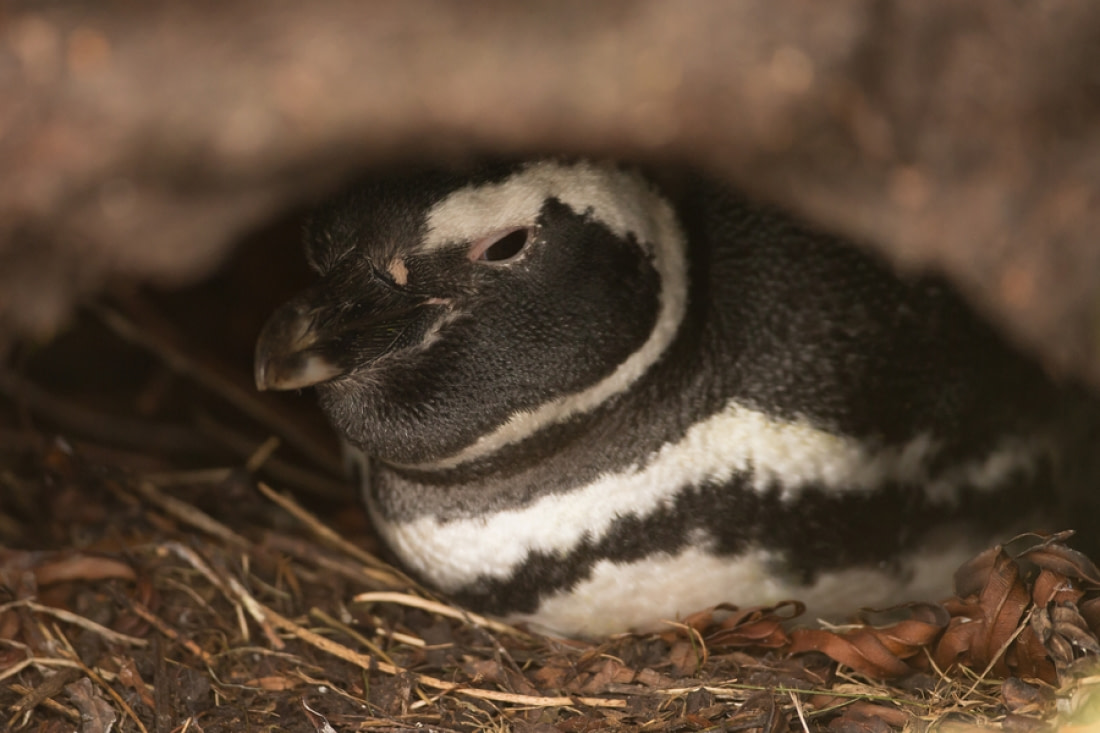
Magellanic Penguin in its burrow at Gypsy Bay, East Falkland (Mike Watson)
At sea between The Falkland Islands and South Georgia (8–9 November)
Today was another special day! It featured our first light-mantled sooty albatrosses, with four sightings of this supersonic graceful albatross. They circled Plancius numerous times, affording some wonderful views.
The southern royal albatrosses we saw today came all the way from either Campbell or Auckland Islands in the New Zealand Subantarctic!
We also saw our first endangered grey-headed albatross today, another South Georgia breeding bird, and a white-headed petrel, seen and photographed from the bridge wings while most were either sleeping or vacuuming their belongings in preparation for the South Georgia biosecurity check. This bird came all the way from Crozet or Kerguelen in the Southern Indian Ocean.
However, we all enjoyed the strong passage of Atlantic petrels all day, presumably heading in the same direction away from the eye of the depression following us towards South Georgia. Atlantic petrel breeds in the Tristan group.
Late in the evening, after sundown, we crossed the Antarctic Convergence, but it was difficult to discern any difference in birds heading towards or away from the convergence itself. We also saw our first of many black-bellied storm petrels today, struck by how easy they were to identify even at extreme distance.
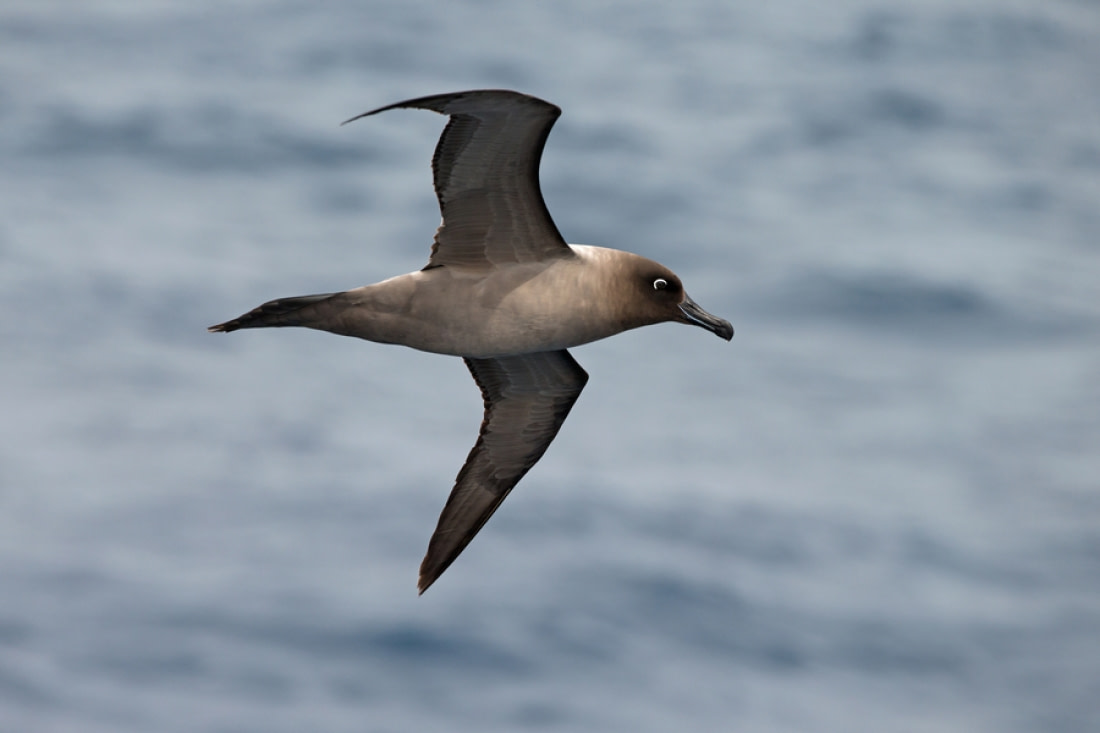
A magnificent Light-mantled Albatross at sea east of the Falklands (Mike Watson)
The sea was again very bumpy the next morning, with a swell of more than three metres (9.8 feet), but occasional combined wave crests easily doubled that.
Watching albatrosses shearing effortlessly across such a sea is one of the finest sights. We logged another three wandering, six southern royal, three each of light-mantled (sooty) and grey-headed as well as many black-browed.
Our first snow petrel appeared today, and northern giant petrels started to appear among their much commoner southern cousins with greater frequency. Blue petrel also made its first appearance amongst the prions on this stretch, which were all Antarctic now that we had left the Falkland Islands far behind.
Blue petrel is one of the smartest petrels and has a white tail tip, which shines like a light in dull weather.
Also today, we saw four soft-plumaged petrels and our first South Georgia shag and Antarctic tern. Macaroni penguin, South Georgia’s commonest penguin, made its first appearance in the sea off the Plancius’s bow.
After another 15 hours of observation today, we were ready for our bunks this evening.
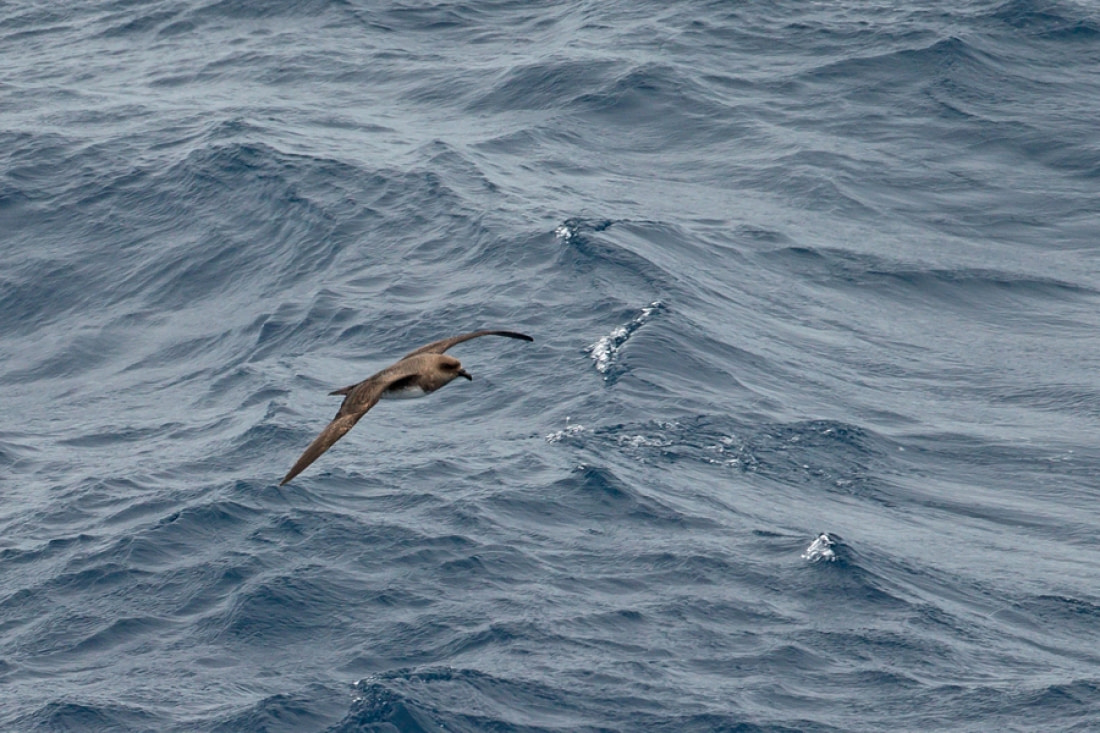
Atlantic Petrel, at sea east of the Falklands (Mike Watson)
Grytviken, South Georgia (10 November)
Today was another classic day! Maybe the most dramatic of the whole cruise, for some?
We started with some seabirds as we cruised down the northeast coast of South Georgia in the morning, snow-capped mountain peaks on the starboard side. It was still winter down here. King penguins started to appear in the water as we continued on our way, and another three wandering, three light-mantled and eight grey-headed albatrosses also made their appearances, and appropriately the snow petrel tally increased to eight.
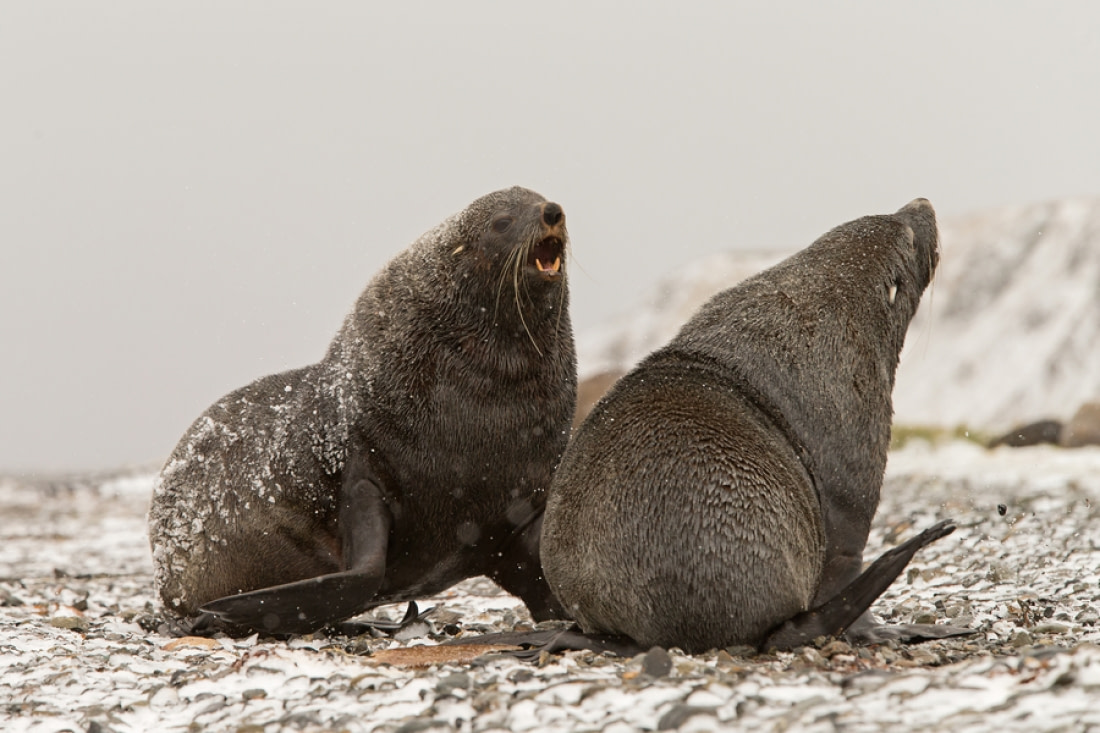
Antarctic Fur Seals fighting on the beach at Grytviken below Shackleton's grave (Mike Watson)
However, the former whaling settlement at Grytviken is the landing that those with an interest in polar exploration look forward to here. After a little deliberation, our bold expedition leader, Ali, decided to take us ashore in some rather windy weather. After all, no one wanted to miss this one.
It was still windy, and clouds behind the mountain wall threatened as we landed in the comparative shelter of King Edward Cove, just a stone’s throw from the small graveyard containing the grave of Irish explorer Sir Ernest Shackleton.
We all gathered graveside to take a look at his very impressive headstone and make a toast with everyone’s favourite Guatemalan explorer, Eduardo Rubio-Herrera. It was a special moment for many of us, having read so much about Shackleton.
MEN WANTED for hazardous journey, small wages, bitter cold, long months of complete darkness, constant danger, safe return doubtful, honor and recognition in case of success. Ernest Shackleton, 4 Burlington Street.
Our return to Plancius from Grytviken was rather exciting too, with winds recorded by the bridge as gusting up to 71 knots. I kept thinking about a hot shower and a hot chocolate as we circled, waiting for our turn to come alongside. It is always very nice to get back on board the big warm ship!
Big thanks, particularly to Teun Van't Verlaat and Kasper Jaeger, for some superb Zodiac driving in difficult conditions to get us all back on board safely.
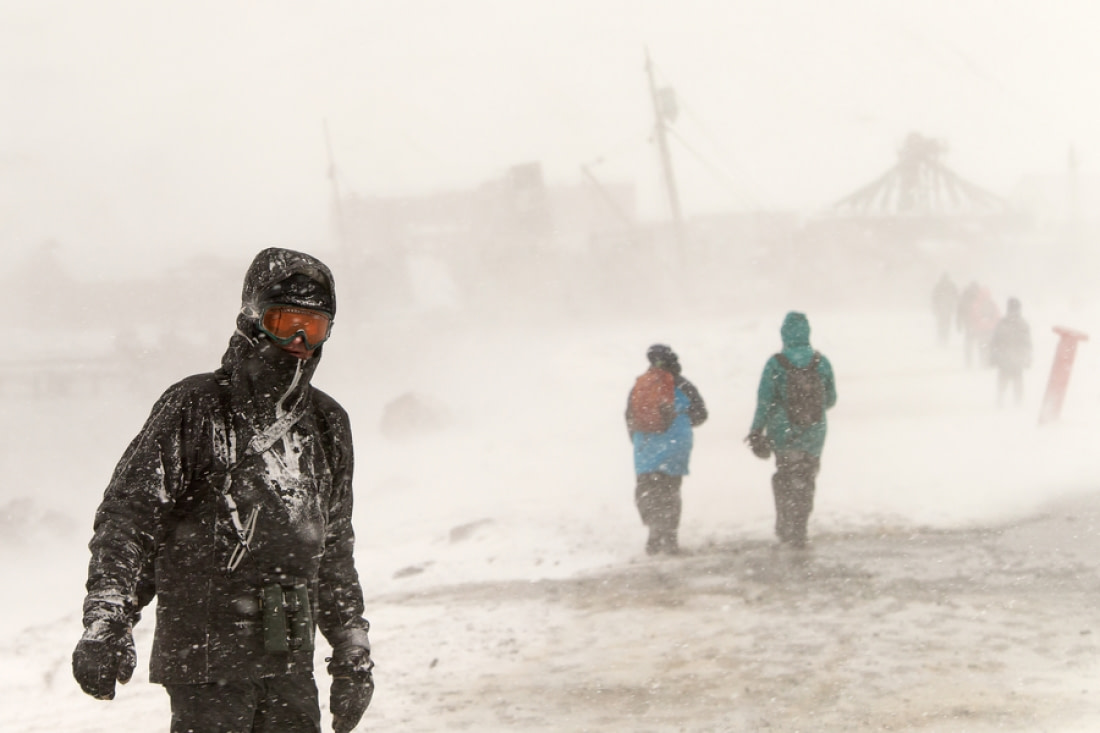
John Arkle enjoys another whiteout at Grytviken, exciting times! (Mike Watson)
Before I get totally carried away by the incredible history associated with today’s landing location, there was also some excellent wildlife at Grytviken! This landing also saw our first encounters with Antarctic fur seals.
Like super-sized rottweilers with flippers, they look a lot scarier than they actually are, and they can be kept at bay simply by raising your foot to them. Nevertheless, it is best not to take any unnecessary liberties, so we kept a close eye on them when getting down for a lower-angle photo with snowflakes in the air. Fab-u-lous!
We also got our first point-blank king penguin encounters here (South Georgia) as well as yellow-billed pintails (the world’s only carnivorous duck, owing to its habit of feeding on corpses – life on South Georgia is hard).
A couple of southern elephant seals were lounging around the beach too, with brown skuas in attendance as Antarctic terns flew overhead.
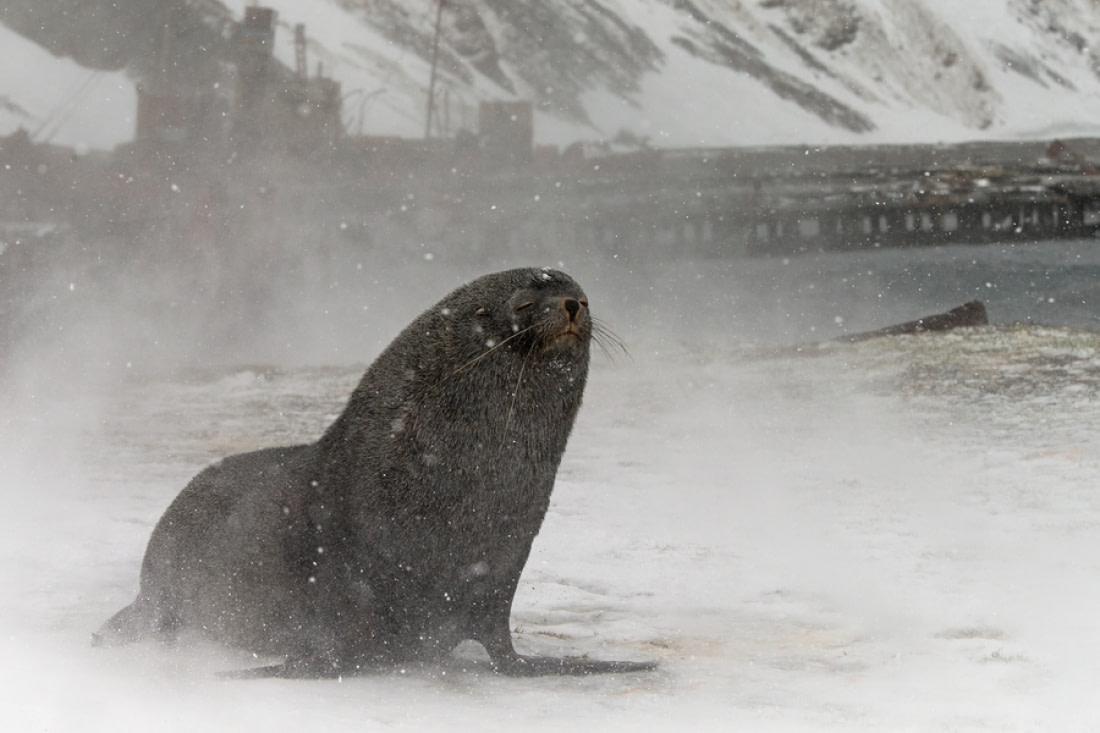
Antarctic Fur Seal in the snow at Grytviken (Mike Watson)
A couple of us even managed to see South Georgia pipits before the snow closed in and several whiteouts ensued.
After exploring the remnants of the whaling station, which closed down in the 1960s, as well as the post office, boat gallery, and the really excellent little museum, some of us hiked out to King Edward Point. This is the permanent UK base where we saw some more feisty fur seals and a few southern elephant seals.
We felt like we had done something today as we sailed away, more snowflakes filling the air.
Rosita Harbour and Salisbury Plain, South Georgia (11 November)
Early this morning we neared the tiny Prion Island off South Georgia’s northeast coast, well known as the last outpost of the diminutive South Georgia pipit (before the successful rat eradication programme returned it to the whole of mainland South Georgia’s east coast).
We even saw one at sea, not far from Prion, keeping up with Plancius in the lee of her bow for a while! After a brief recce of its west-facing landing beach, rammed with fur seals, during which the wind picked up significantly, we got the news that our planned landing had been cancelled and with it our only chance of seeing the majestic wandering albatross at its nest.
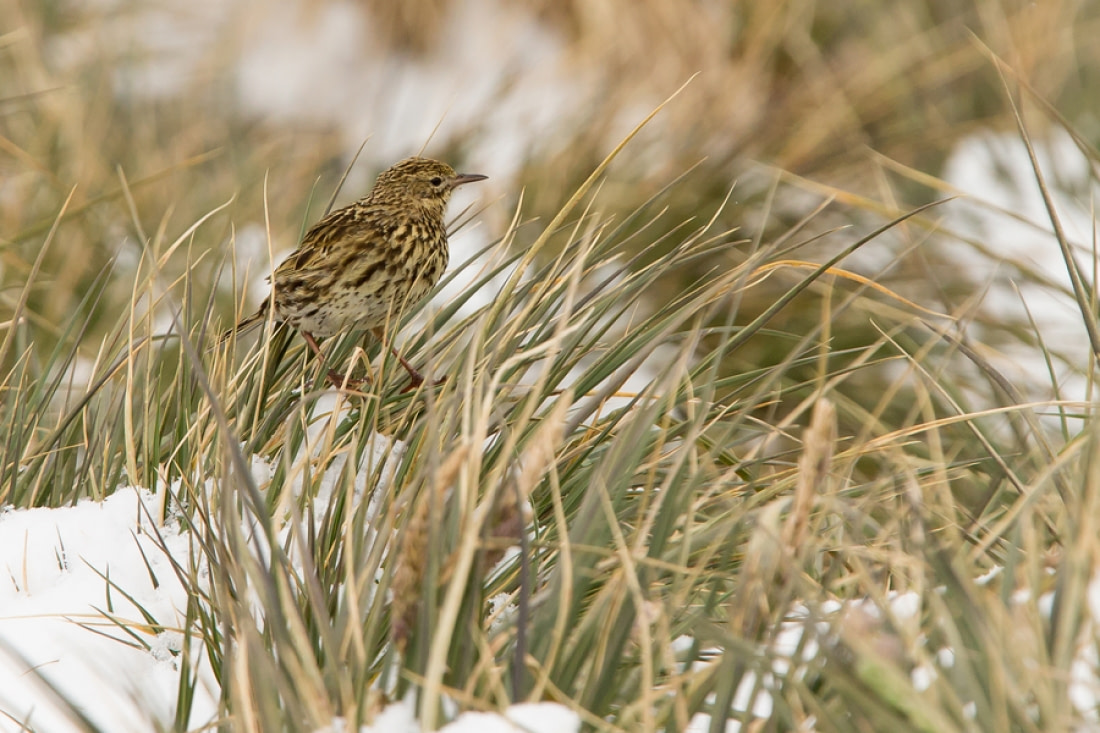
South Georgia Pipit at Rosita Harbour (Mike Watson)
Instead, we continued farther northwest to Rosita Bay, an east-facing landing and much easier in the continuing wind. We made a nice, if somewhat brief, Zodiac landing here, in subzero conditions with flurries of snowflakes in the air.
The South Georgia pipits here were in full song-flight mode and spring was in the air, even though there was still plenty of snow on the ground. The fur seals were quite feisty here as well, but the few elephant seals were much more sedate and relaxed.
After admiring these superb creatures from a tussock grass vantage point for a while, we returned to Plancius and its lovely hot chocolate coffee.
Later in the afternoon, the wind had dropped a little and our planned landing at the world famous king penguin metropolis of Salisbury Plain could go ahead. After our intrepid expedition staff had made a pathway between the ubiquitous fur seals, we were all taken ashore.
We got our first good views of snowy sheathbill. A small group of these unbelievably dumb birds were scavenging among the seals on the beach. The main attraction here of course is the massive (more than 60,000) king penguin colony, and we gazed in awe at the massed ranks of penguins stretching far into the distance from the beach and up the surrounding hillsides.
Brown skuas and giant petrels of both species hung around the colony, looking for an easy meal. We saw a couple of the penguins with bad injuries, maybe the result of leopard seal attacks? It was surprising that they were still alive.
The sheer number of penguins was overwhelming, and it was difficult to know exactly what to look at, there were so many. From time to time, my eyes just glazed over.
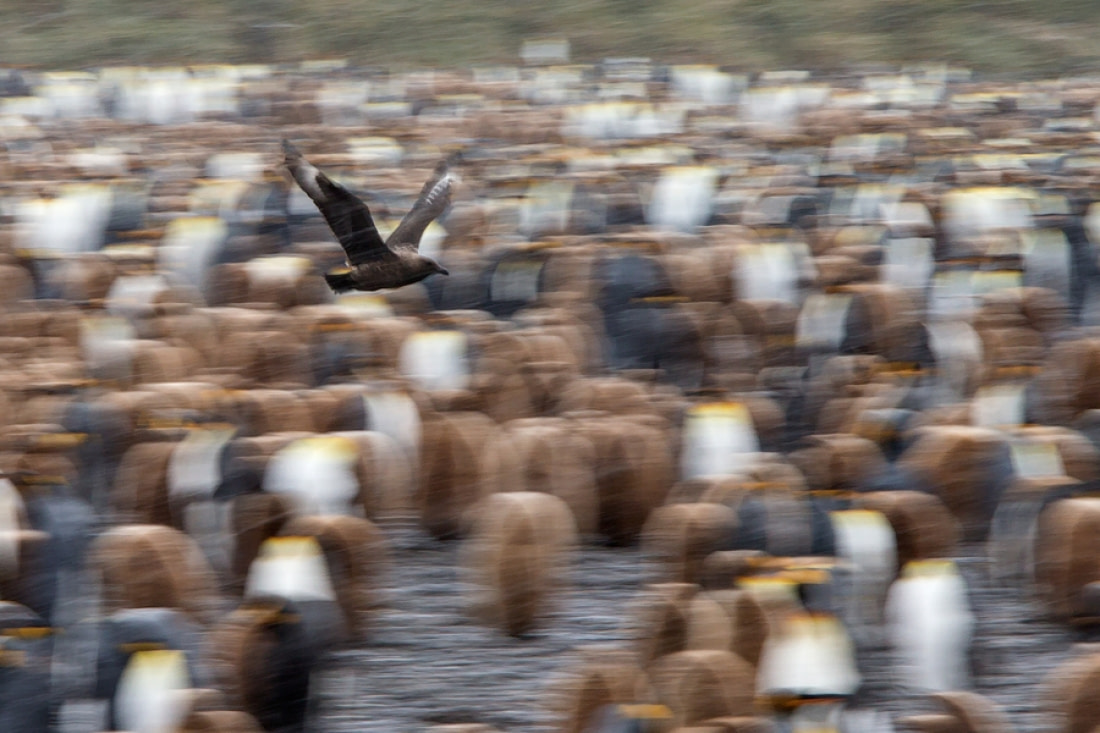
Antarctic Skua over the masses of King Penguins at Salisbury Plain (Mike Watson)
St. Andrew’s Bay, South Georgia (12 November)
Today was without doubt our best in the South Atlantic!
Sir David Attenborough described St. Andrew’s Bay as the “Serengeti of the South”, and it certainly lived up to this bold statement. The steep, wide beach here is a difficult landing, and fortunately we had a window of some very calm weather in which to make it.
We awoke at 0400 to a glorious sunrise, a calm sea, no wind, and the announcement that we were going ashore. We actually made two landings, one before breakfast and one after. The latter was preceded by a short Zodiac ride along the beach for a different perspective.
Spectacles are the new megas in birding and this one takes some beating. The 150,000-strong king penguin colony is simply breathtaking. The beach is full of elephant seals, with harems and their attendant beach-masters and usurpers scattered all along the shore.
Thankfully, there were not many fur seals here. All of this was against a terrific glaciated mountain backdrop. To put our good fortune into perspective, this was only the second time that Mike from German tour operator Icarus had managed to land here out of eight attempts!
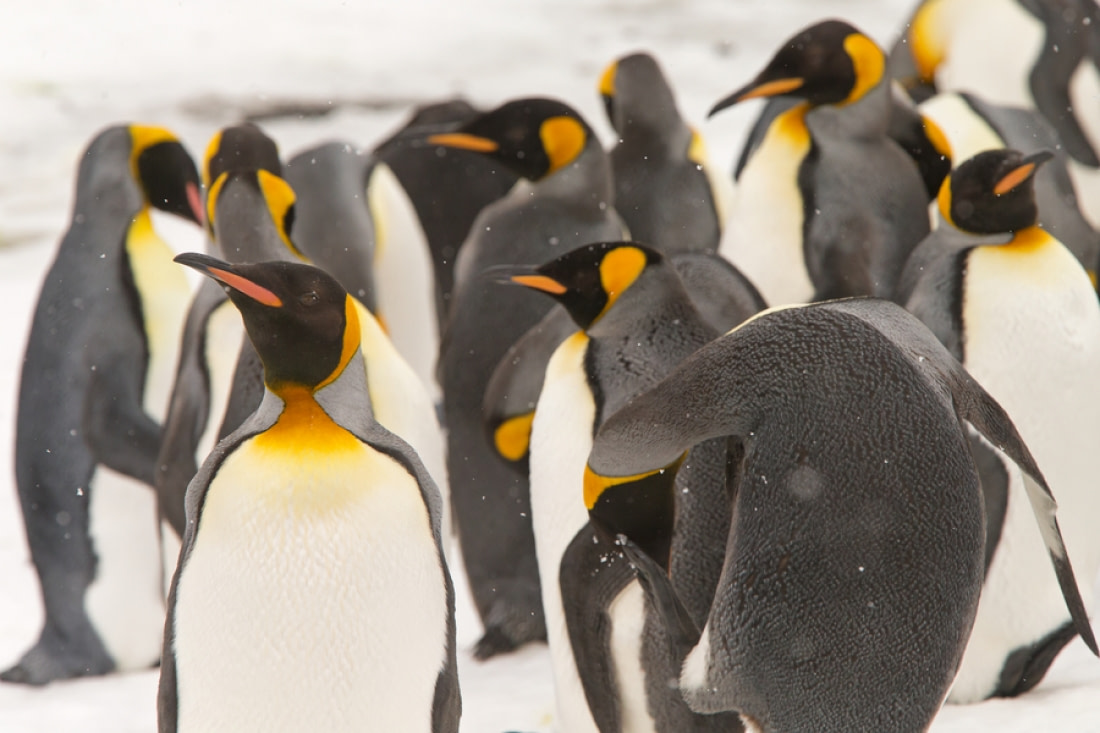
King Penguins (Mike Watson)
The afternoon saw us make another Zodiac landing at nearby Godthul, which means “Good Cove”. With the weather worsening, our landing was ultimately curtailed, but not before some of us had clambered up the tussock-grass-covered slopes to a gentoo penguin colony, where we could watch the comings and goings of birds to their grass mound nests.
Brown skuas were again in attendance, as were southern giant petrels, which were also nesting nearby. Some of the other passengers went on a hike to see the view from a hill overlooking the bay, but we simply enjoyed extra time with the penguins.
The beach at Godthul is the site of a former whaling station, and there are some relics of this horrible industry in the form of whalebones all over the beach and some rusty tanks and other industrial paraphernalia.
The weather closed in again quickly, and the return Zodiac ride to Plancius was another wet one. The maximum gusts recorded by the bridge on our return ride were 40 knots.
The thought crossed my mind that I must get one of those 100% waterproof sailing jackets. Standard hiking showerproof and breathable jackets are simply inadequate in Antarctica in the spring.
Gold Harbour, Cooper Bay, and Drygalski Fjord (13 November)
We started the day with a Zodiac landing at the lovely Gold Harbour on South Georgia’s southeast coast. It is smaller than Salisbury Plain and St. Andrew’s Bay but even more picturesque, with king penguins, southern elephant seals, Antarctic fur seals, and the best glaciated mountain backdrop of all.
We could also get much closer to the king penguins youngsters here, or was that the other way around?
The wind increased throughout the morning as we sailed around the southern tip of South Georgia, and by the time we passed Cooper Bay, the bridge recorded gusts of 51 knots, so no Zodiac operations were possible here.
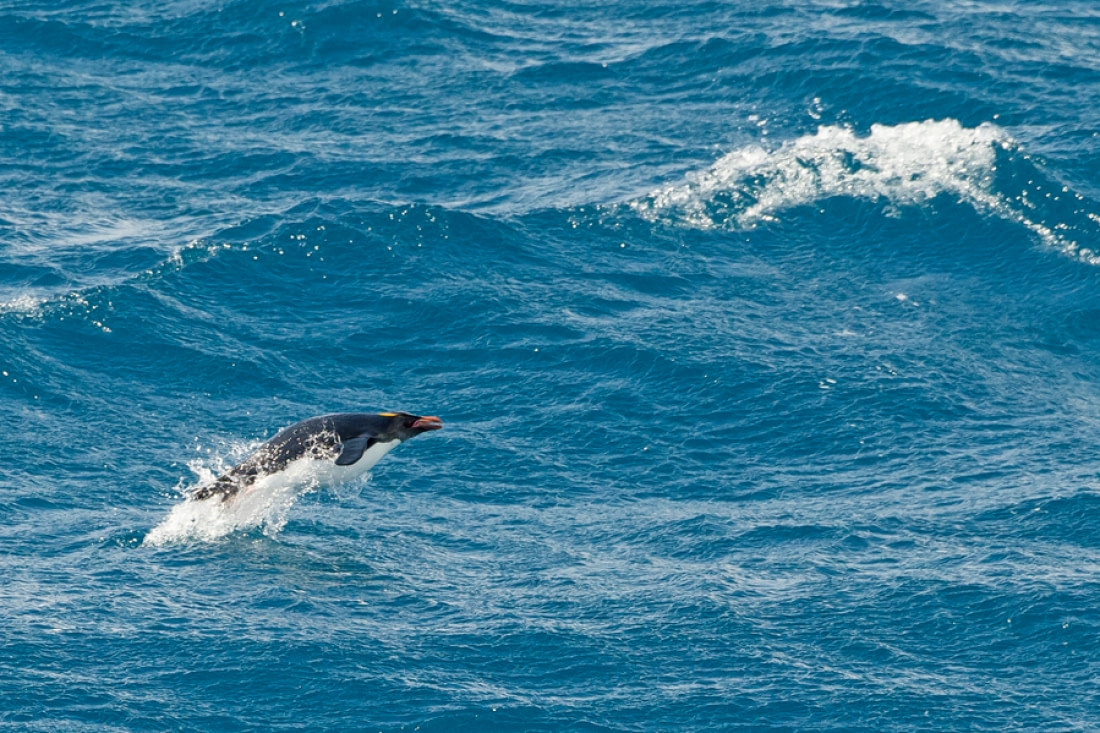
Macaroni Penguin at sea, Cooper Bay (Mike Watson)
We could see the massive macaroni penguin colony in the distance, but at least we could get some good views of them in the water as Plancius cruised past.
Our first chinstrap penguins were here as well, along with new favourites like light-mantled (sooty) albatross. It was difficult to stand up on the bridge wings, let alone point the camera today.
Lunchtime saw us enter the dramatic Drygalski Fjord, a 11-km-long (6.8 miles) but narrow fjord named after German geographer and professor Erich Dagobert von Drygalski (1865–1949), the leader of the First German Antarctic Expedition 1901–03.
A good number of snow petrels was seen here as the weather closed in and snow started to fall. We also saw a couple of spectacular calvings of the icefalls on the surrounding cliffs as well as waterfalls that did not complete their fall, with the strong wind simply blowing their cascade all over the place.
We reached the glacier at the head of the fjord, turned around and headed back out to sea, bound for the South Orkney Islands. As we left South Georgia, we saw around 25 diving petrels.
All were dusky-headed, though, and therefore just common. Some have very whitish wing linings, just like the two bird strikes that I was able to see on board Plancius.
Identifying South Georgia diving petrel in the field is very difficult indeed. This evening also saw some mountainous seas, the red wine in tumblers at evening meal and a depleted restaurant as folks sought refuge in their cabins.
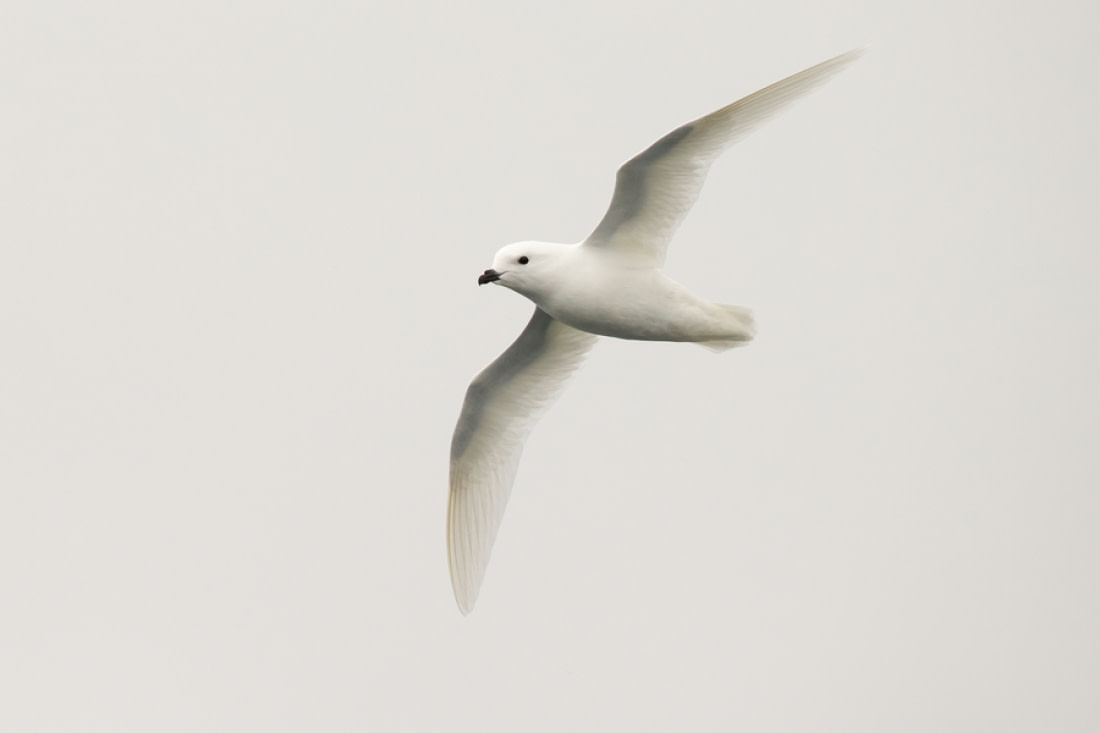
Snow Petrel (Mike Watson)
Cruising towards South Orkney Islands all day (14 November)
Another day at sea, with conditions calming from 6-meter (19.7 feet) swells to some much more enjoyable rolling.
The composition of the seabirds was changing as we cruised farther south. Albatrosses were petering out, with only a few black-browed and a single light-mantled (sooty) today, but blue petrels were on the increase. Although we put in a lot of effort today in the hope of a Kerguelen petrel, we were not rewarded.
Orcada Base, Laurie Island, South Orkney Islands (15 November)
At last we had left the “furious fifties” behind and had reached the “serene sixties”. Lying 600 km (373 miles) to the north of the Antarctic Peninsula, the South Orkney Islands were first discovered in 1821 by two sealers, Nathaniel Brown Palmer and George Powell.
Originally named “Powell’s Group”, the archipelago was given its present name by James Weddell, who visited them in 1823, owing to their location being roughly the same latitude south as the Orkneys are north, 60 degrees.
After we passed a few large tabular icebergs, the bright orange units of the Argentinian Orcada Base on Laurie Island loomed through the murk.
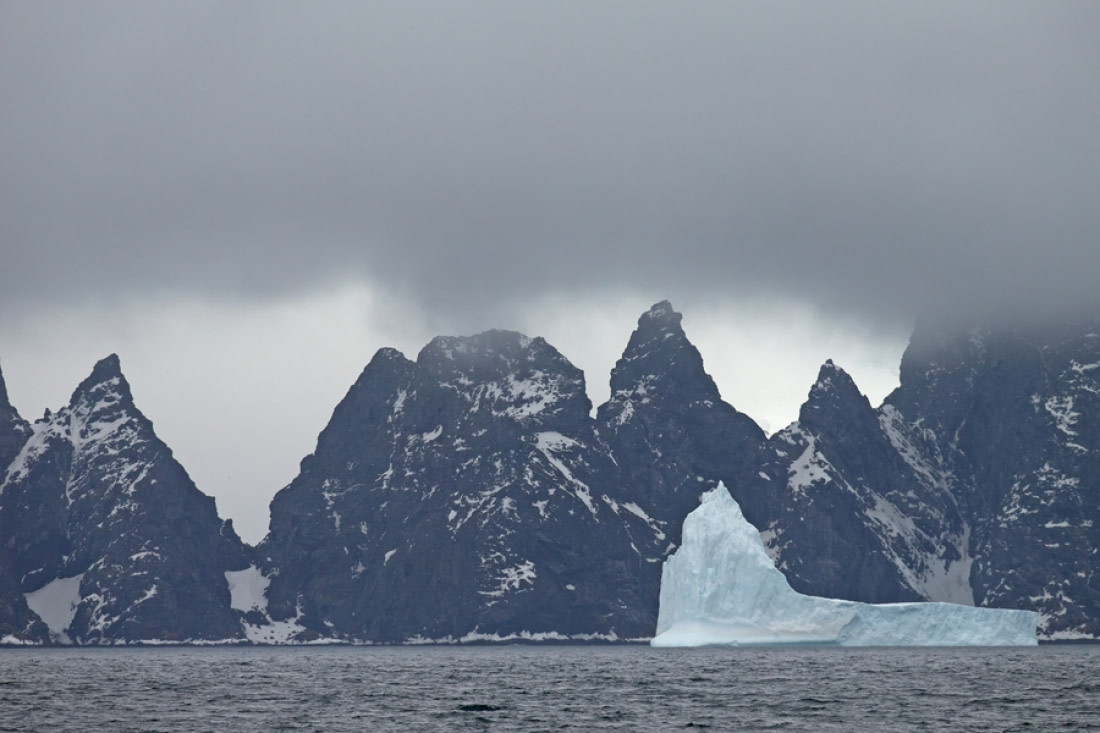
The jagged South Orkneys coastline (Mike Watson)
We were fortunate that the sea ice had cleared and the swell on the south-facing landing beach was not too great. A delegation of four penguins greeted us on the snowy landing beach: three gentoos and one Adelie, our first of the trip! There was also a couple of chinstraps farther along the beach.
After shedding our life jackets, we plodded through the sleet to have a look around the base. The Argentinians were very pleased to see us. We were only the second ship to land anyone here since February, and they were also happy to receive some of the supplies we took ashore.
The staff also showed us their emergency route up the adjacent cliff face in the event of a tsunami warning. Their base occupies a very low-lying piece of land between two bays and is vulnerable to a tsunami wave.
As we left the razor sharp peaks of the South Orkney Islands behind, we started to encounter even more impressive tabular icebergs and could see their previous sea level lines as explained by our amazing on-board glaciologist, Andreas Alexander.
These would be the best icebergs we saw on the tour, some blue with compression. Fab-u-lous!
The bird of the day today was probably cape petrel, which appeared in large numbers and came over to check us out for a while. Still no Antarctic petrel yet, but we had to keep trying. Cetacean sightings today included several humpback whales as well as fin and sei whales, the world’s second and third biggest.
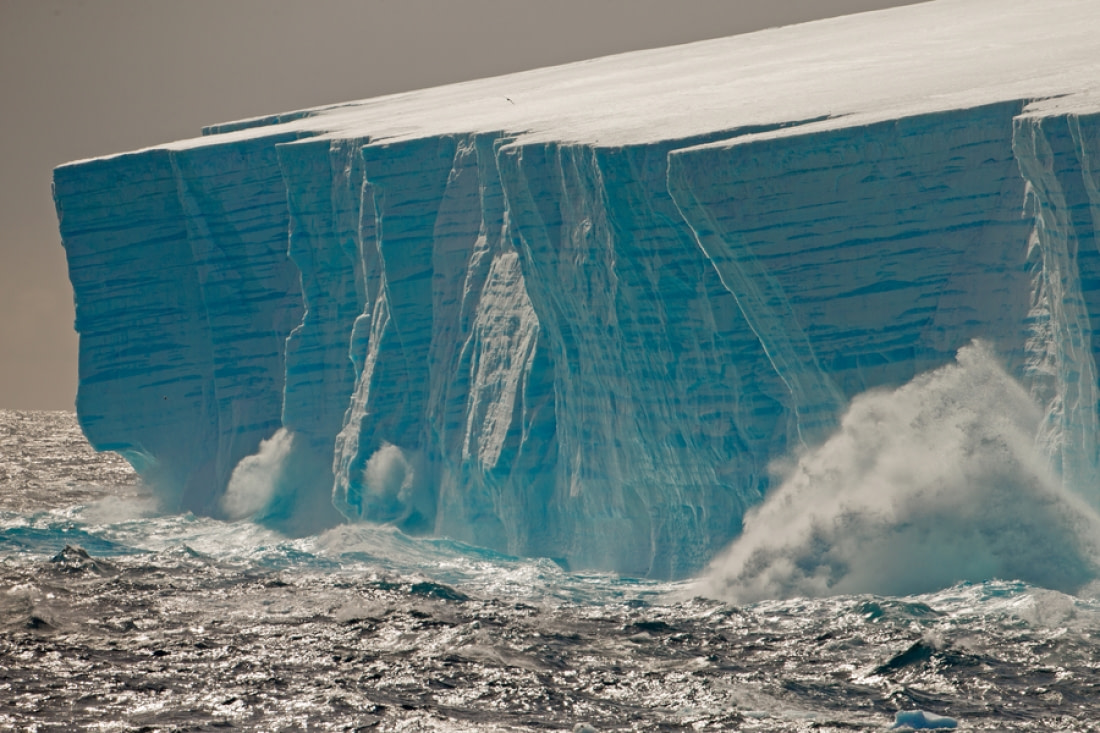
A massive tabular iceberg south of the South Orkneys (Mike Watson)
Cruising towards South Shetland Islands all day (16 November)
Another seabirding all-dayer, with highlights of light-mantled (sooty) albatross and white morph southern giant petrel.
Cape petrel numbers peaked today, but still no Antarctic or Kerguelen petrels. Several Antarctic minke whales were spotted today too.
In the evening, we encountered Iceberg B-09F, so large it has been named. We could see it was at least 21 nautical miles long (38k km). It is part of a larger iceberg, which broke off from the Ross Sea ice shelf in 1987 (Ross Sea icebergs start with the letter B) and drifted more than 2,000 km (1,240 miles) to its present position.
Earlier in its life, in 2010, the berg had been responsible for the deaths of 150,000 Adélie penguins when it cut off access to their colony at Cape Denison in Commonwealth Bay.
Penguin Island and Maxwell Bay, King George Island, South Shetland Islands (17 November)
This morning we arrived in the snow-covered South Shetland Islands. If you are wondering why we came here instead of in the Weddell Sea, as we ought to have been by that time, it was because there was a big storm forecast for the east side of the peninsula, so we had to divert to the South Shetlands while it passed.
This morning also saw our only Antarctic petrel sighting, only available for the early watch as it disappeared into the distance after circling the boat for a while with cape petrels. Our first Antarctic shags followed soon afterwards.
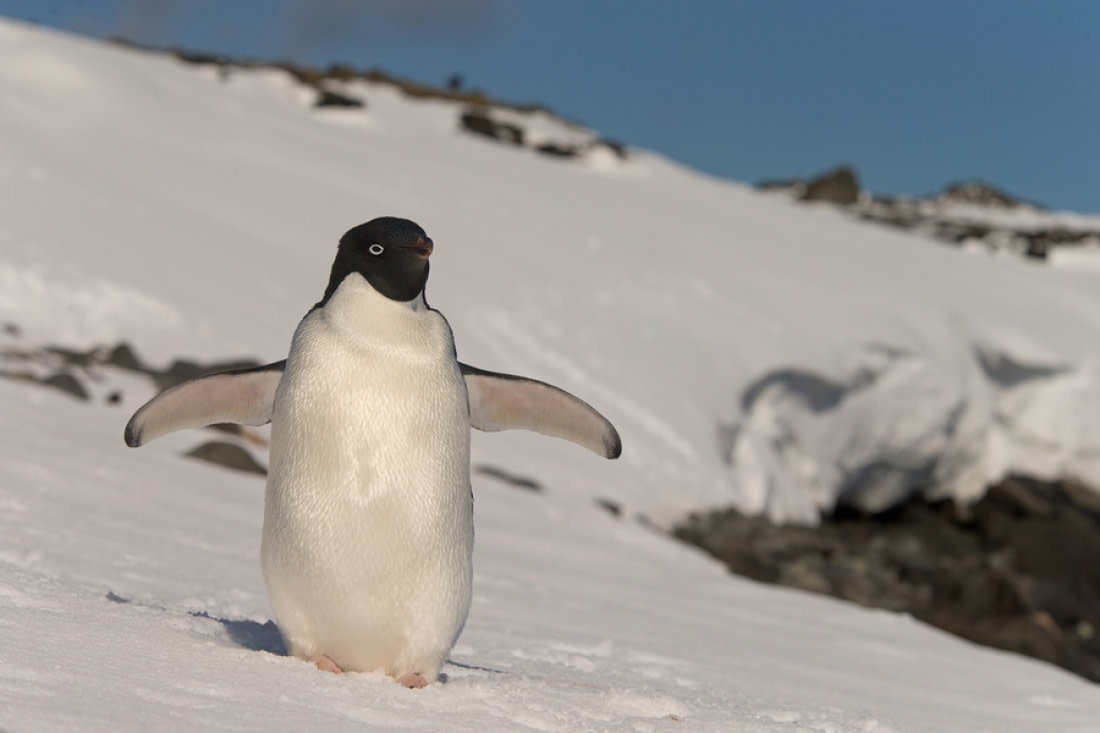
An adorable Adelie Penguin greets us at Penguin Island in the South Shetlands (Mike Watson)
Unfortunately, the westerly wind was presently throwing a heavy swell onto our preferred landing spot at Turret Point on King George Island, so instead we opted for the relative shelter of the aptly named Penguin Island just offshore, but with a northeast-facing landing beach.
The lucky early birds were rewarded with a leopard seal, which investigated their Zodiac before moving on. Some of us hiked towards the peak at the top of the volcanic island while others stayed down lower and enjoyed the packed chinstrap penguin colonies.
There is a small Adélie colony on the other side of Penguin Island, but our expedition leader was concerned about the length of time it would take to get folks back from there if the weather changed for the worse, as indeed it did by the time our landing came to an end.
The occasional flurries of snow made time with the hundreds of chinstraps even more atmospheric as they waddled back to their partners with stones for their nests. These birds (I often think of penguins as being something other than birds) were pioneers and were staking a claim to the best breeding sites, even before they were snow free.
Ali reminded us that penguin colony landings become a real mess after the turn of the year, and it is trickier to find clean penguins to take photos of!
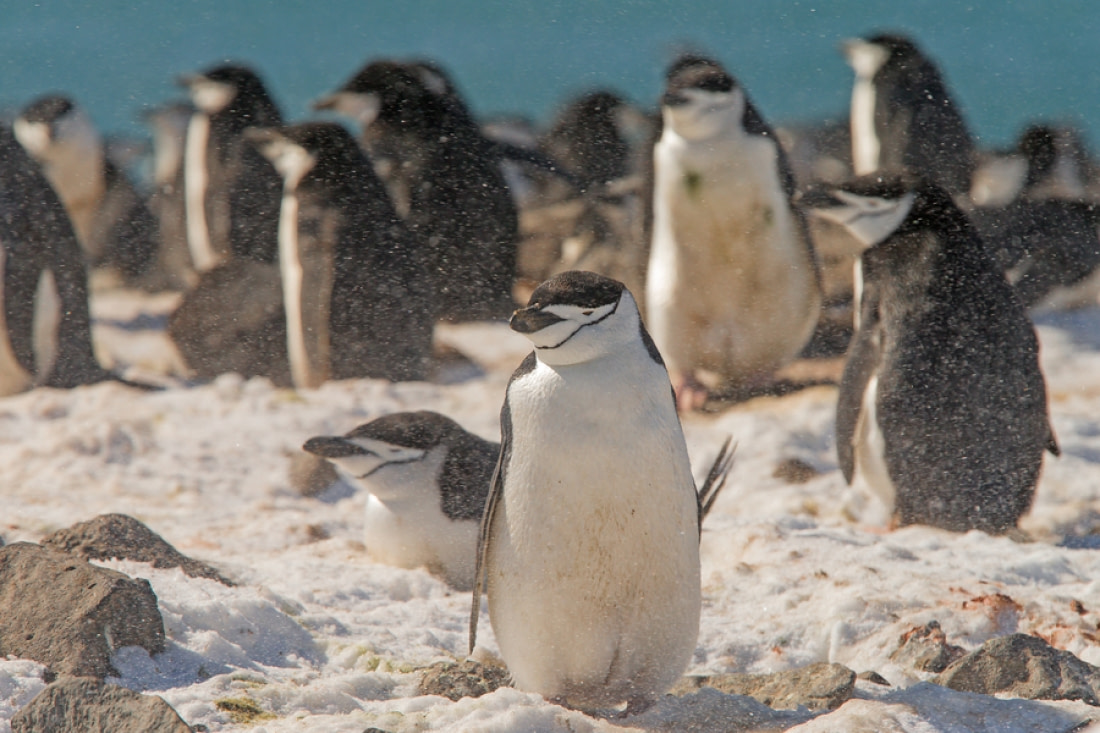
Chinstrap Penguin colony in the South Shetlands (Mike Watson)
The wind picked up dramatically this afternoon, presumably the tail end of what was happening in the Weddell Sea, as we headed west along the southern coastline of King George Island.
Our afternoon landing in Maxwell Bay was at the Bellingshausen Russian Base, and again we were greeted here by a delegation of penguins, mostly gentoos but also a few chinstraps.
There were some Adélies on a distant shore. Unfortunately, the Adélie colony at the entrance to Maxwell Bay only allows a very limited number of folks ashore at a time. But it was too exposed for the Zodiacs this afternoon anyway, so our last chance of an Adélie colony landing slipped away.
Some hiked up to the little Russian Orthodox Church on the hill overlooking the bay, where the priest was conducting a service. Others hung around on the shore where sharp-eyed Tim and Dawn saw another leopard seal.
A Russian guy was smoking some fish in a metal tin near the water’s edge, the smell of which had attracted a south polar skua.
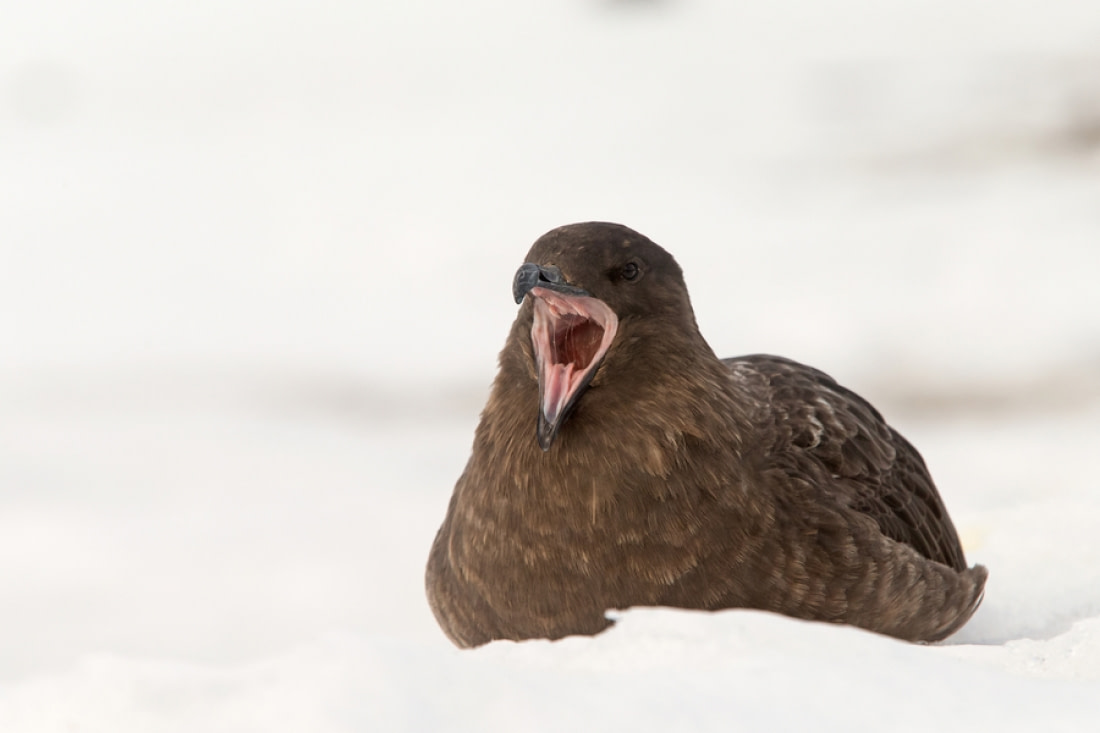
South Polar Skua, Maxwell Bay, South Shetland Islands (Mike Watson)
Wilhelmina Bay, Bransfield Strait (18 November)
Today was very quiet from a birding point of view. We managed just 11 species, the most interesting being southern fulmars and snow petrels in the ice of Wilhelmina Bay.
This 24-km-wide (15 miles) bay was discovered by the 1897 Belgian Antarctic Expedition of Adrien de Gerlache, who has the nearby strait named after him. The bay itself is named after Wilhelmina, Queen of the Netherlands. The expedition itself was trapped in the Antarctic ice for seven months before eventually returning home in 1899!
Several crabeater seals were spotted on the ice, and there was another claim of a distant leopard seal. Some close but rather inactive humpback whales were seen, but things were otherwise very subdued.
The visibility was rather poor, forcing us to do a U-turn. The expedition staff tried their best to do something constructive in the afternoon, and the resulting Zodiac cruise in the drift ice was very interesting to those with an interest in geography. We steered close to blue icebergs and watched the sea freeze around us, but we only saw a handful of birds.
The hot chocolate laced with Baileys on our return was better! That reminds me, I must get around to buying one of those waterproof sailing jackets…
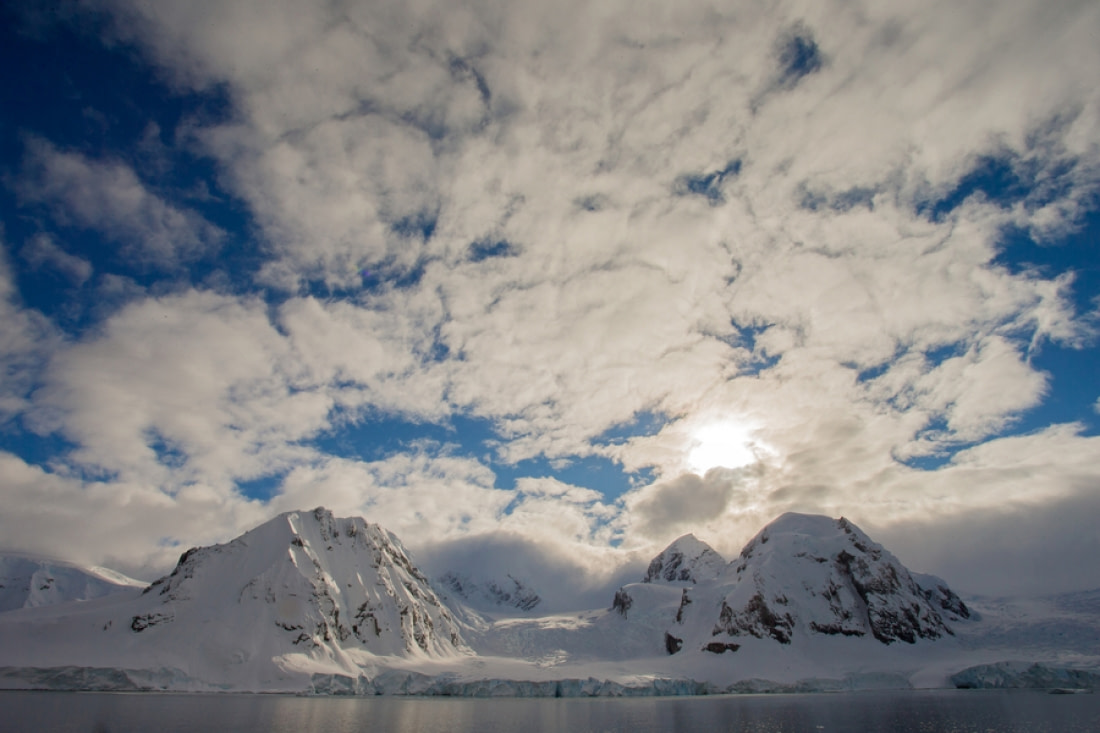
Sunrise over the Danco Coast (Mike Watson)
Danco Island and Neko Harbour, Antarctic Peninsula (19 November)
We had one perfect day in Antarctica, and this was it.
We woke to blue skies, calm sea, and no wind at Danco Island, a small snow-covered islet off the peninsula. The landing here was very easy, and soon almost everyone had strapped on their snowshoes and was heading up towards the gentoo penguin colony at the top of the island.
There was a braided penguin highway to cross first, though, and it took some time before there was a gap, as the penguins always have a green light.
The views today were nothing short of spectacular, with ice-capped mountains all around, and although the bird diversity was close to zero, it was still a very enjoyable landing, watching the antics of the curious penguins.
However, as lunchtime approached, the clouds started to roll in behind the mountain peaks, and before too long the wind was back again and snowflakes were in the air.
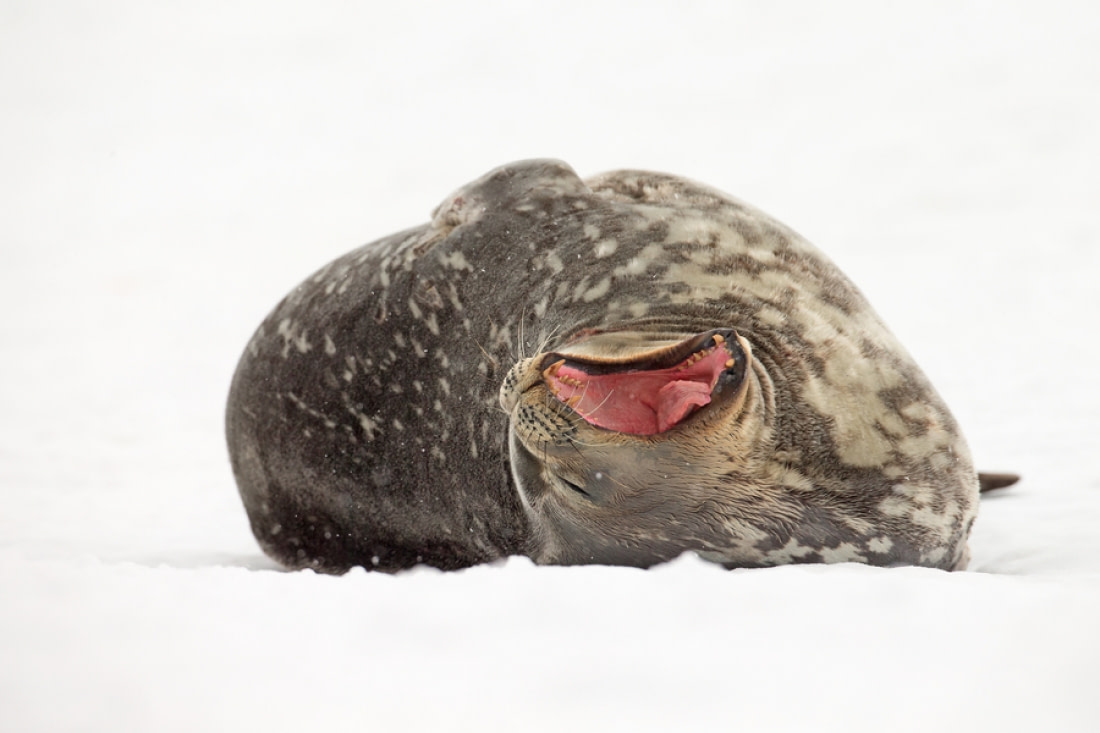
A sleepy Weddell Seal at Neko Harbour (Mike Watson)
A humpback whale put on a great show, diving in front of Plancius for a while, its tail flukes slicing through the ice.
Our afternoon landing was “the big one” for many people. Our destination, Neko Harbour, is another gentoo penguin colony site but has a terrific blue glacier backdrop. There was also one chinstrap penguin here, looking alone in a crowded room.
Some kelp gulls, snowy sheathbills, south polar skuas, and southern giant petrels were hanging around the penguins, and a couple of humpback whales were offshore. Snow flurries came and went before it time came to return to the ship.
This evening saw our postponed barbecue from Grytviken take place on aft deck three, and we had a great time in a very atmospheric setting, partly thanks to the free spiced plonk. Another humpback whale swam over to take a look at us in this idyllic setting.
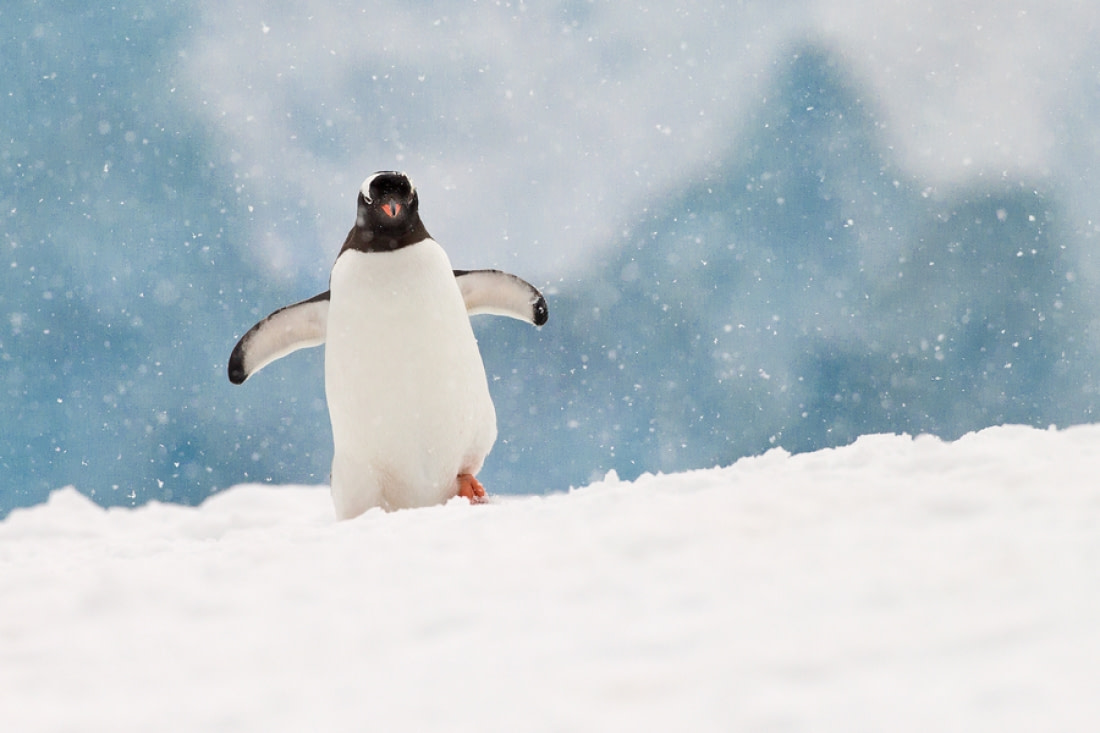
Gentoo Penguin Neko Harbour (Mike Watson)
Melchior Islands (20 November)
The early watch struck gold again this morning with three Orcas, including at least one bull with a massive dorsal fin that surfaced only a couple of times as we cruised past.
With a small window to cross the Drake Passage, we headed north, reaching the Melchior Islands this morning. There is a tiny Argentinian base here, occupied for only a short time each summer. Its huts poked out of the deep snowdrifts on the point of one of the islands.
There were several gentoo penguins by the base as well as a couple of chinstraps. We went on a Zodiac cruise around the islands this morning, admiring the stunning scenery: snowdrifts and icecaps merging into one, huge icicles, and precarious ice slabs waiting to fall.
Birding was quiet again, with only a few Antarctic shags of note as well as some Antarctic and a couple of Arctic terns. From here it was north again towards the Drake Passage.
This afternoon we started to see some ocean-going seabirds again, with light-mantled and black-browed albatrosses and white-chinned petrel reappearing.
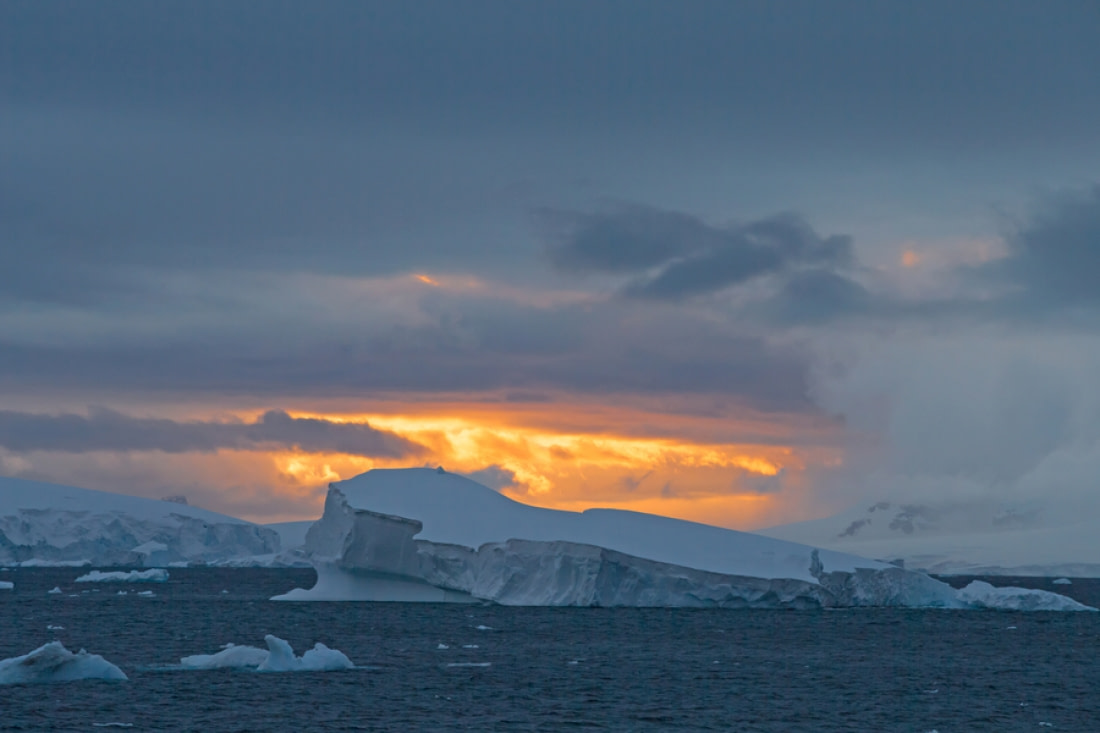
Sunset over the Gerlache Strait (Mike Watson)
Drake Passage (21–22 November)
With only a moderate swell that we were well used to, it was more of a Drake Lake for our crossing. However, there was enough wind to get the tubenoses airborne.
Light-mantled albatross peaked at seven today, and it is always a pleasure when the “moon goddess” shows up. A couple of grey-headed albatrosses was seen, and both blue petrel and Antarctic prion showed up in numbers again – it was difficult to know how many, as some of them may have left and rejoined the ship.
A humpback whale was the only positive ID from many whale blows today, as they are so difficult to be sure of in windy conditions.
Happy hour at the bar this evening included a pub quiz in which we were happy to finish joint 12th last (or 4th, depending on which way you look at it), despite having attending only a few lectures. We did manage to win the best team name, though!
OK, so we got a completely false impression of the Drake Passage, the most feared stretch of water in the world. In fact, it was lovely, just a gentle rolling motion as we cruised along surrounded by great seabirds.
Great albatrosses were with us almost all day (on the second day of our crossing) until we reached the South American continental shelf, and then they were gone.
Southern royals outnumbered wandering again today (they can be tricky without good photos), but we also had a northern royal, thousands of black-browed, and at least five grey-headed. Southern giant petrel was also still with us as were cape and blue petrels.
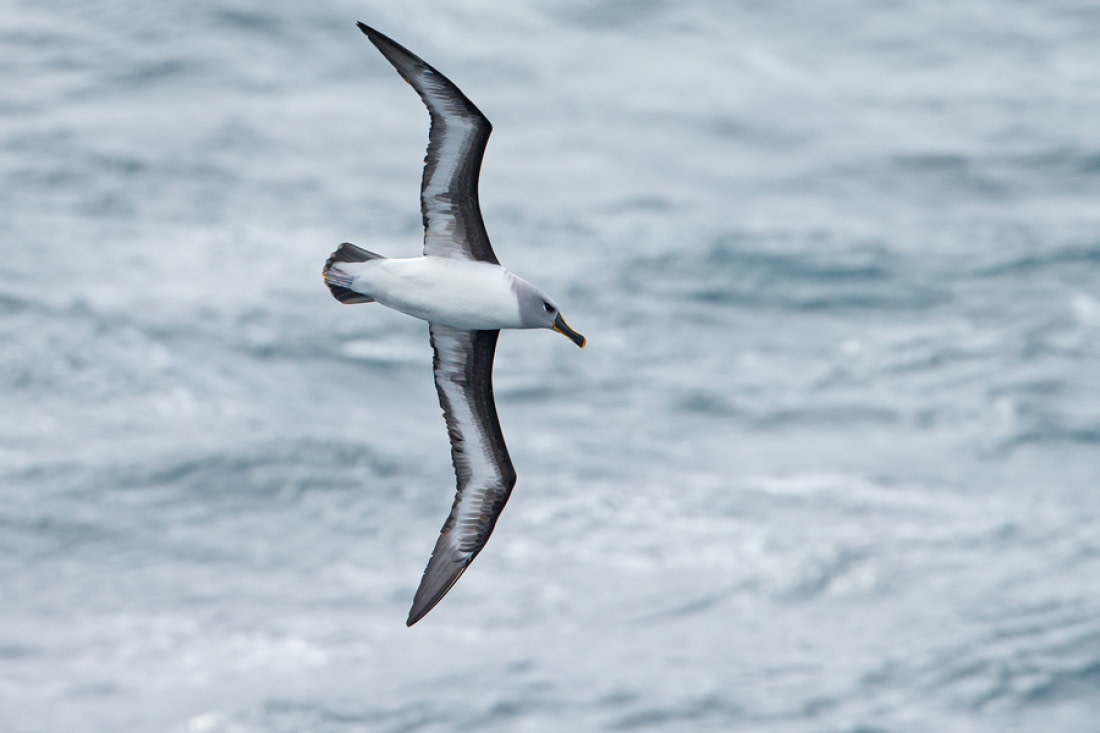
The endangered Grey-headed Albatross is one of South Georgia's most important breeding birds (Mike Watson)
A few diving petrels were spotted, and record shot photos confirmed the white half-collared Magellanic. White-chinned petrels increased as we continued north, but probably the biggest event was running into sooty shearwater traffic up on the continental shelf: Thousands were on the move, mostly going southwest towards Cape Horn, that little dark triangle on the western horizon.
We spent much of the day inside it and therefore out of danger of the nasty storm that was on the way from the northwest. It was already making life a misery for boats behind us in the Drake Passage, so we were happy to have set off some hours earlier than planned.
In the evening we entered the Beagle Channel, and though it was now very windy, these waters did not trouble Plancius, which has lovely lines that cut through the big waves.
We started to see lots of different inshore birds now: Magellanic penguin, imperial shag, kelp gull, South American tern (thousands), and our first Chilean skuas. The last cruise meal this evening was a very stable one for a change, as we chugged along very slowly, killing time until our pilot from Ushuaia arrived.
Disembarkation Ushuaia (23 November)
Disembarkation always seems to happen very quickly, and soon after arriving in the port of Ushuaia in the early morning, we were walking down the gangway at 0830.
We managed a few extra birds before the tour ended, including flying steamer duck, southern lapwing, chimango caracara, and Chilean swallow. Black-browed albatross and southern giant petrel were still with us almost until the jetty in Ushuaia, the latter an ever-present entry on the daily log.
Finally we were back, thanks to the captains and crew of Plancius as well as our excellent expedition leader, Ali Liddle, and her staff. They all worked so hard to keep us safe and make this a very memorable voyage, cruising almost 24/7.
Thanks also to our merry band of Birdquesters who embraced the adventure we were taking part in.
One thing I learned is that, once you have made this voyage, you will want to return. There is so much to see, and mostly thanks to the Antarctic and Southern Ocean weather, you cannot see it all on one cruise.
This cruise remains one of the world’s classic wildlife expeditions. It is simply a bucket-list experience for anyone interested in the natural world and who has the time and resources to make the dream a reality.
My overwhelming feeling was of being very privileged to be able to visit such a remote part of the planet, where we have done relatively little to screw up the natural world – compared to what we have done almost everywhere else.
The astonishing number of birds and other wildlife was overwhelming at times. Added to this was some very impressive scenery, all visited via the comfort of our expedition ship, Plancius, which made for an unforgettable experience.
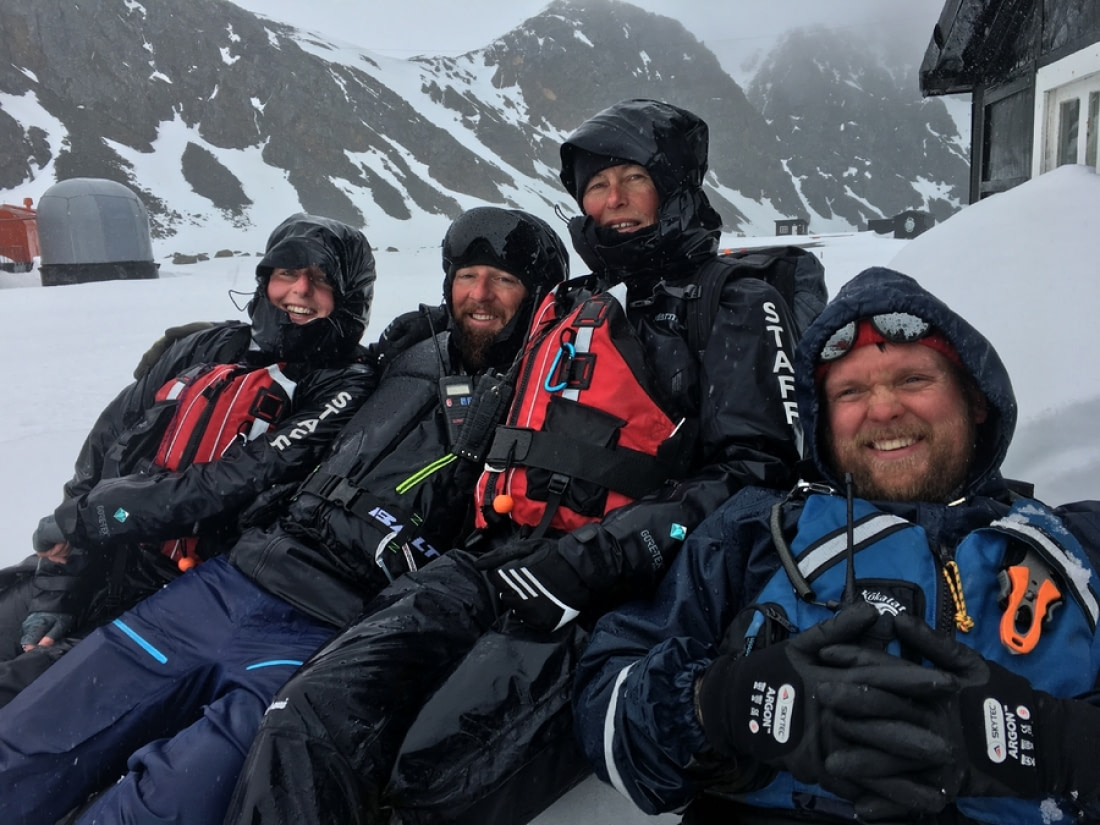
Big thanks to our excellent Expedition Staff, some of whom are pictured here in the South Orkneys, (l-r) Pippa Low, Daniel Höhne, Expedition Leader Ali Liddle and Assistant Expedition Leader Kasper Jaeger.
